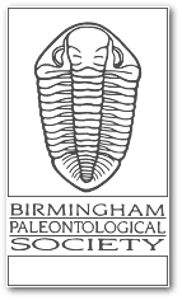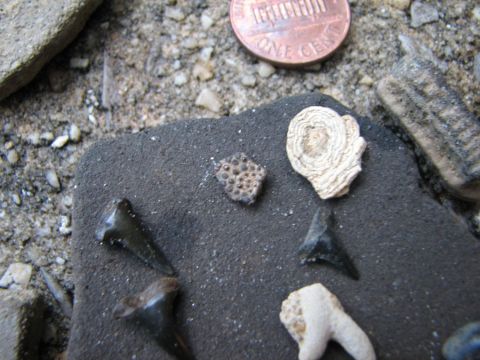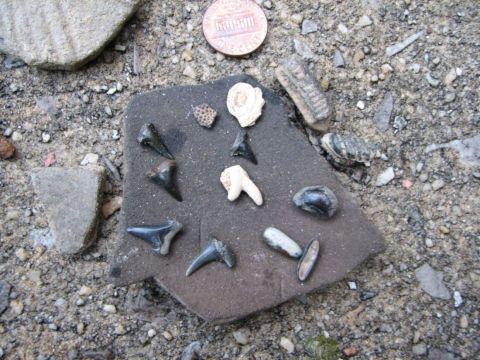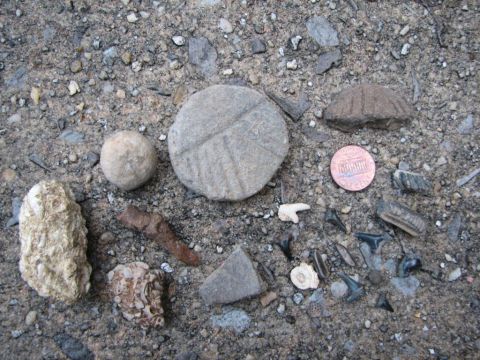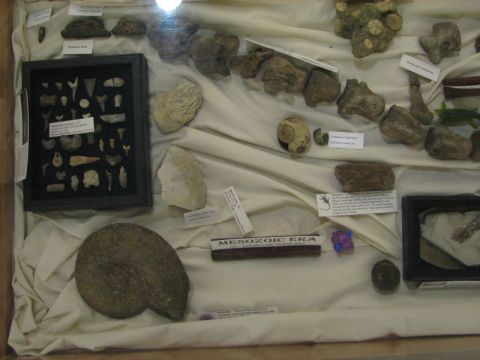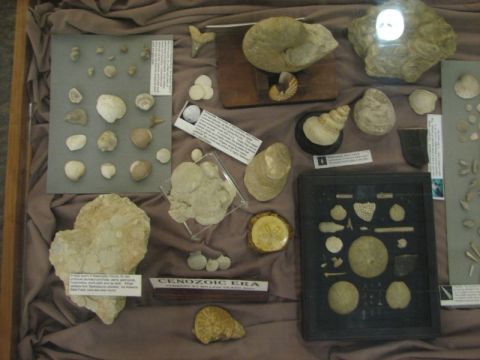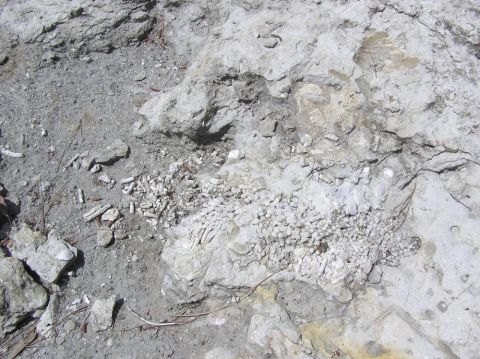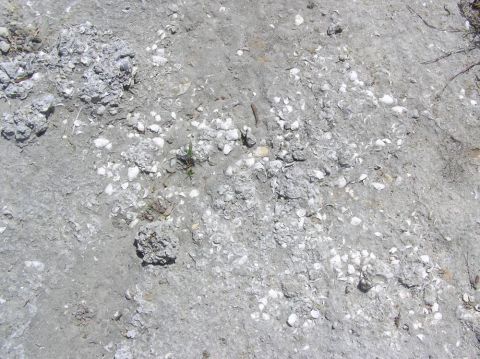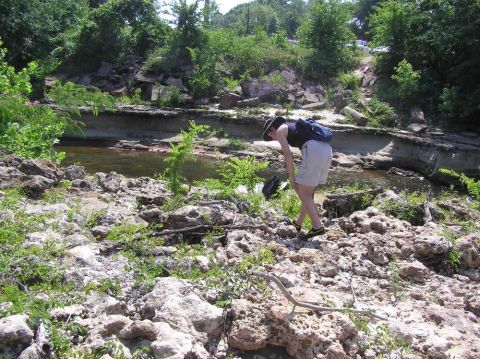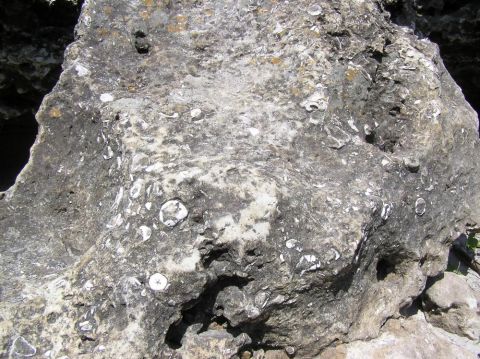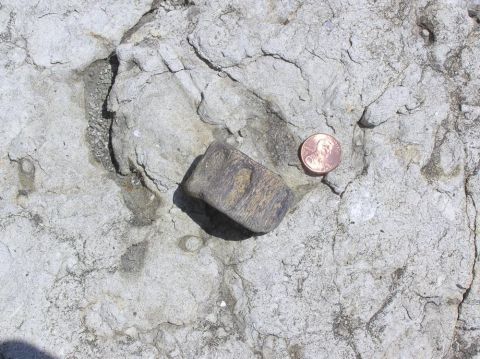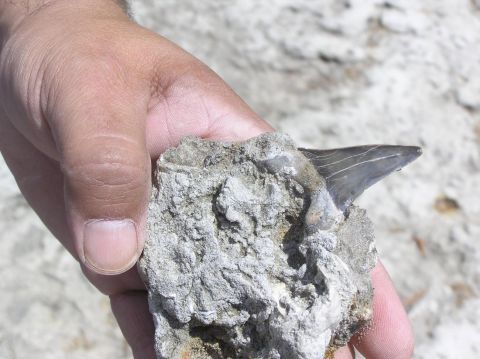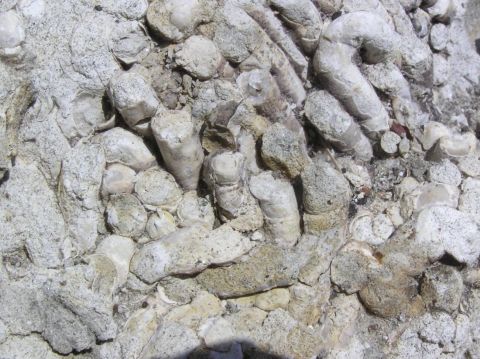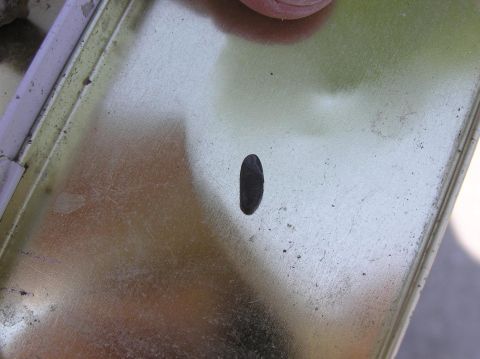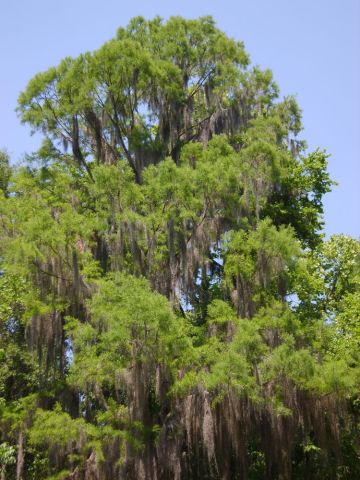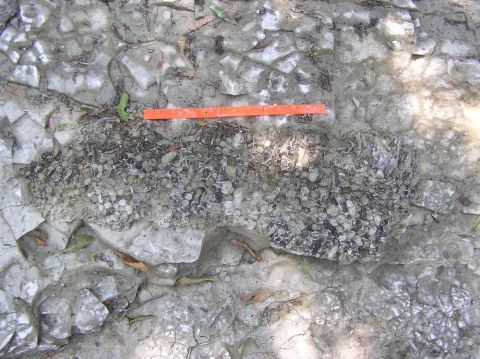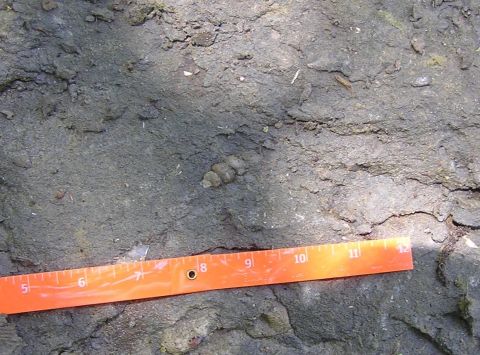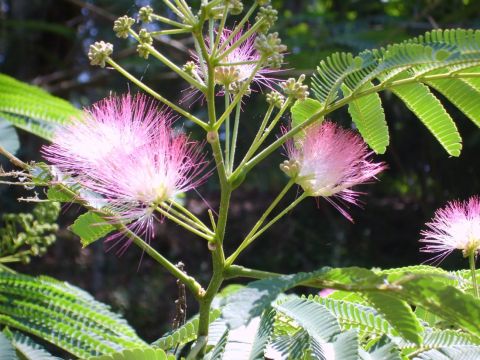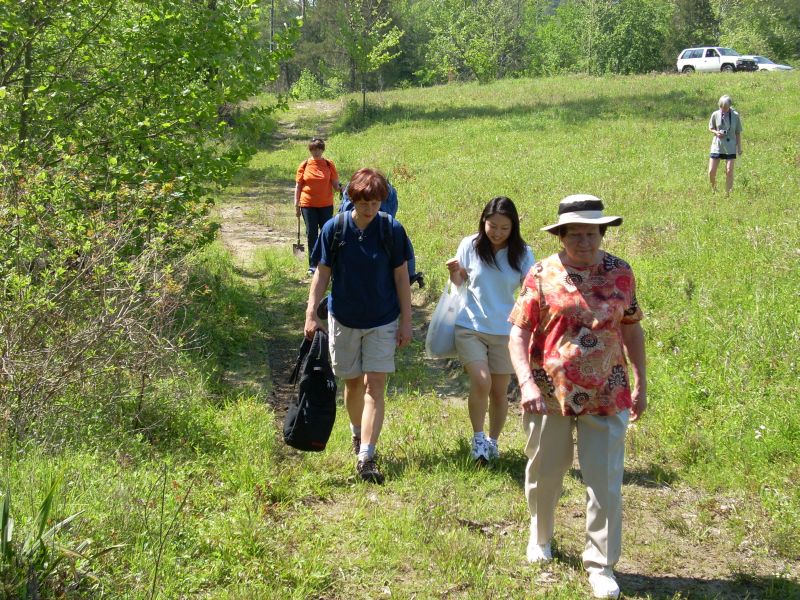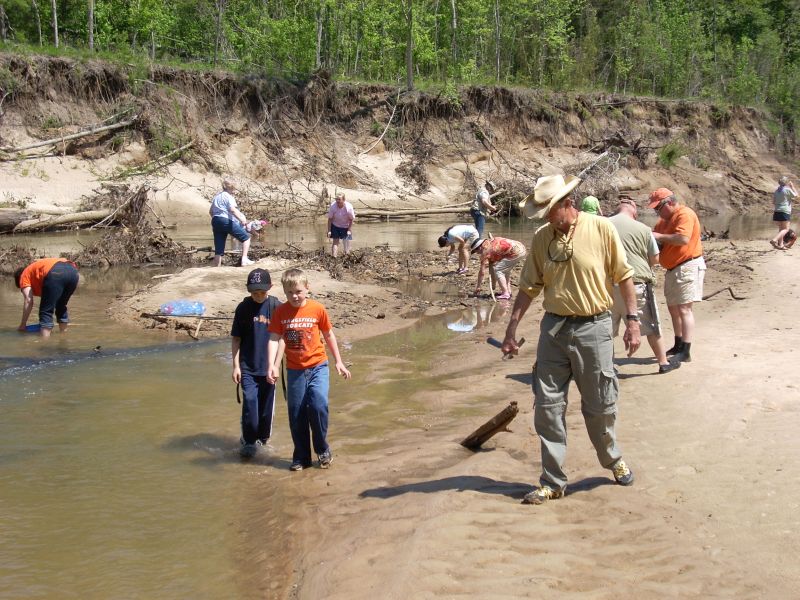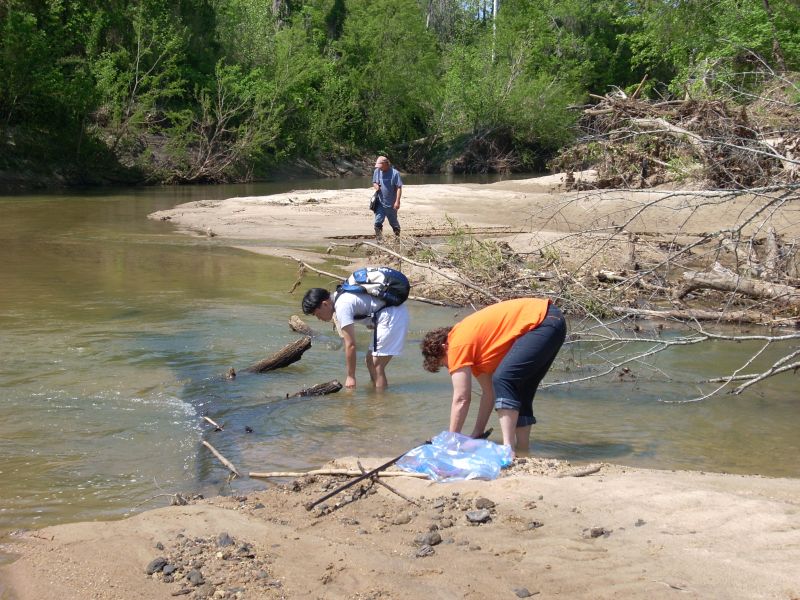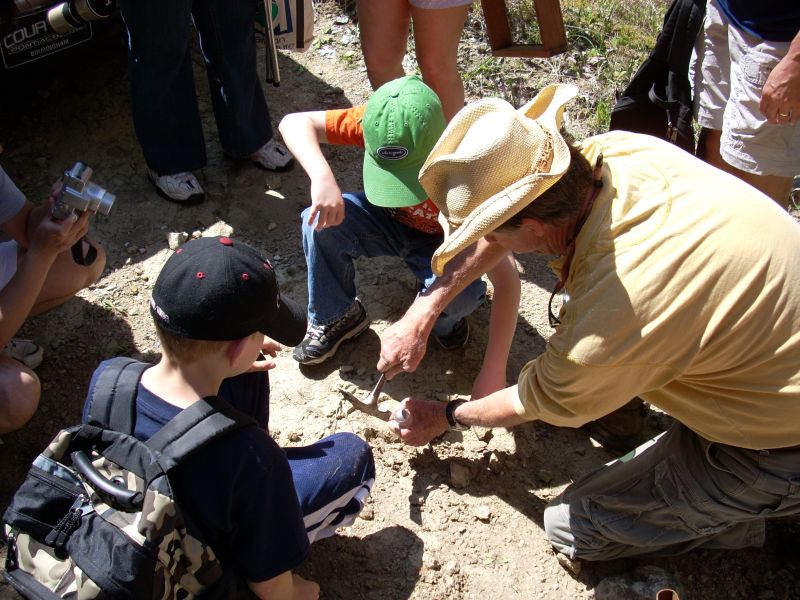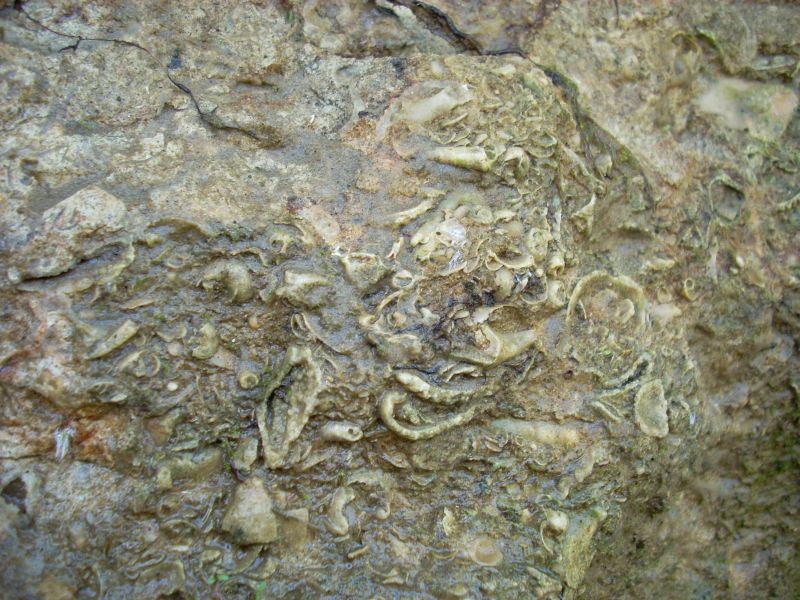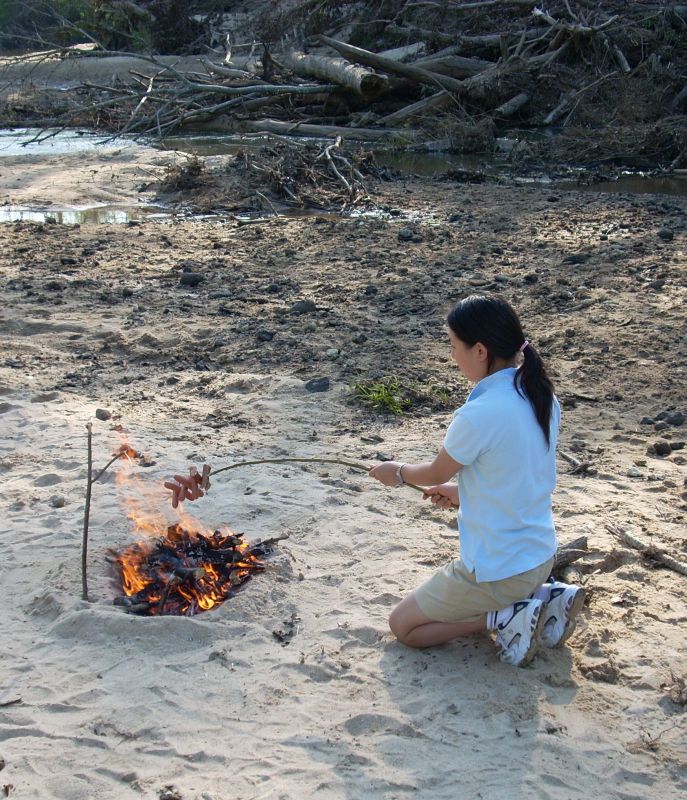Some nice echinoids.
Visitor
shark teeth
08-04-vl-shark-teeth_8041
Leisa's shark teeth and other items displayed on pottery shard.
08-04-vl-leisa-fossil_8039
Various items found, including cochina, shark teeth, ray teeth, pottery, echinoid
June 23, 2007 - Eocene Fossils, Covington Co, AL
Unlike previous years, we were the only collectors that day. It appeared that some "cleanup" work had been done along the riverbank, because it was smooth and un-marred by the holes and trenches dug by commercial collectors in previous years. The landowner asked that we DO NOT DIG at this site, and hopefully, the word has gotten around (BPS never dug here, anyhow). Screening is ok, but NOT digging holes in the banks. Since a number of our members have been appalled in the past at what appeared to be irresponsible digging by people who didn't even know they needed permission to collect here, this was welcome news.
We found ray teeth, shark teeth, sting-ray spines, brachiopods, drumfish mouth plates, and some mystery pieces. Stay tuned! The river was a wonderful place to cool off on such a hot day, so BPSer's took full advantage. Several members camped out overnight (thanks for the A/C, Leisa!), and broke out the canoes the next day in hopes of spotting some more collecting areas. We found some shark and ray teeth, a live turtle badly wanting out of the hole it had fallen into, and had a very pleasant trip UP the river, but did not find the treasure hole we were seeking. So, obviously, we have to go hunting again, right guys?
(Photos courtesy Claire Smith and Vicki Lais)
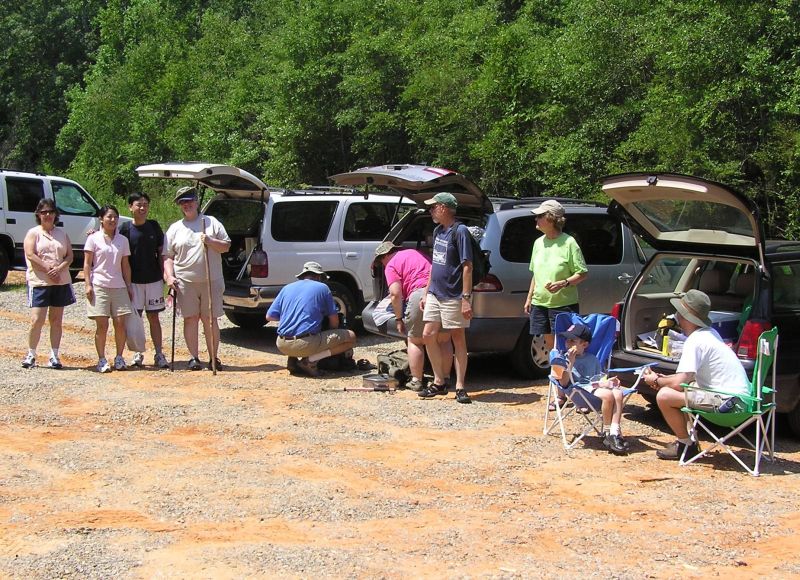
The group picture, hey, what can I say? We were late, hot, and hungry!
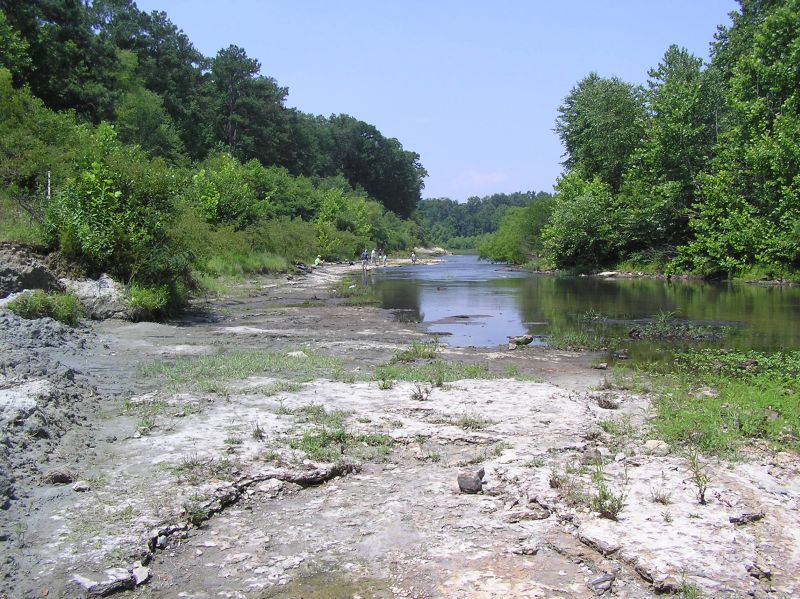
Very low water level today.

Members hunting for the best collecting spots - the river is quite shallow here.
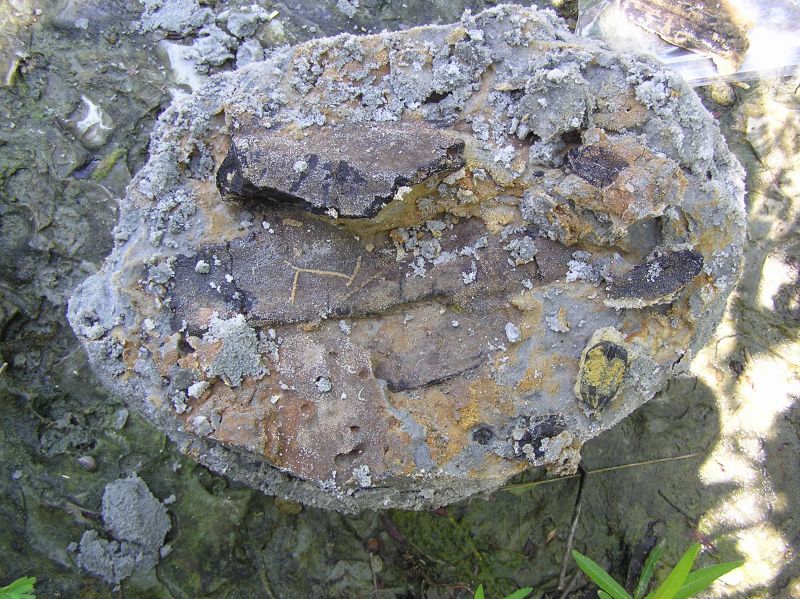
Jan found several pieces of petrified/ permineralized wood, and what appears to be a nice seed pod.
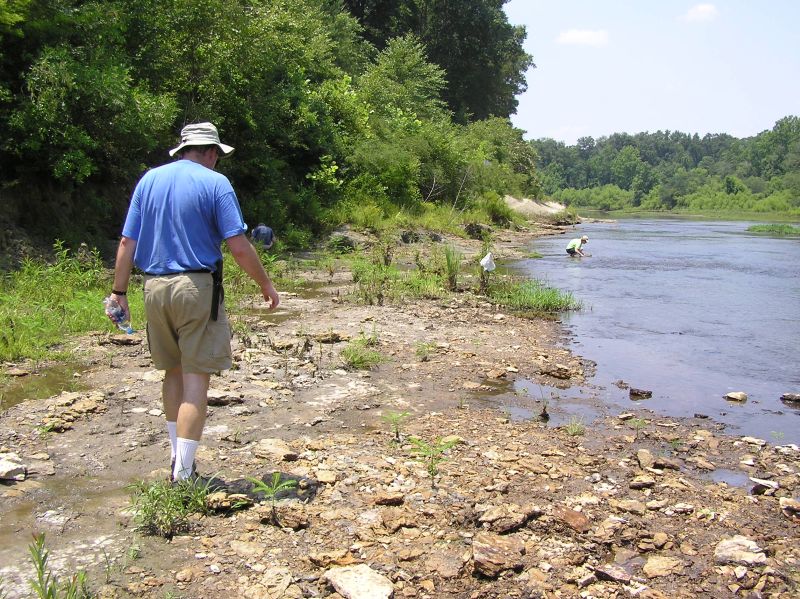
Jan heading downstream, surveying areas that are normally covered with water.
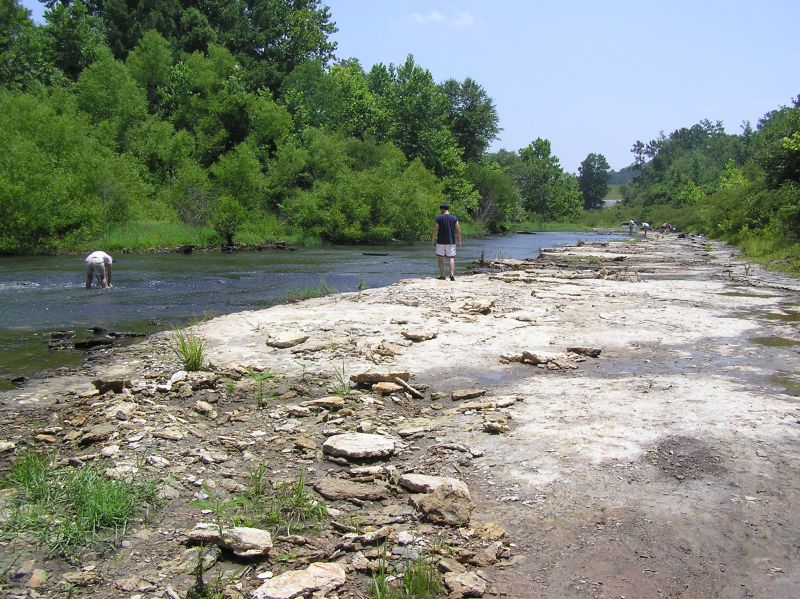
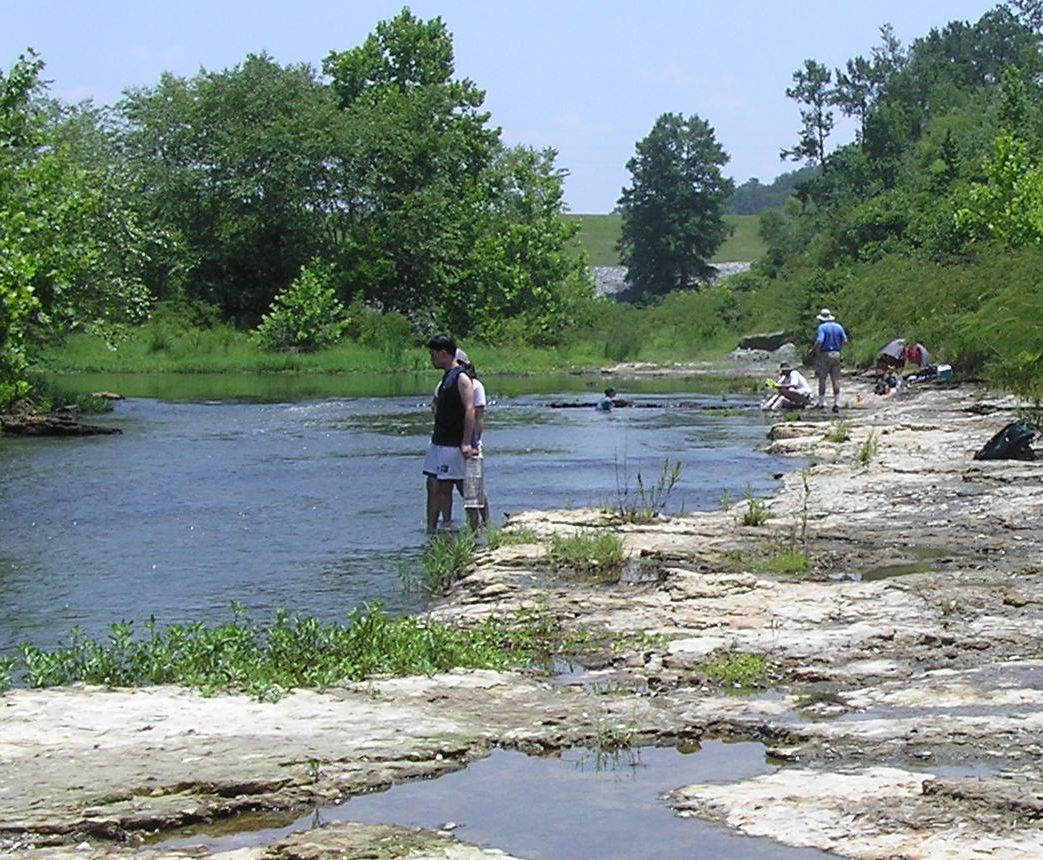
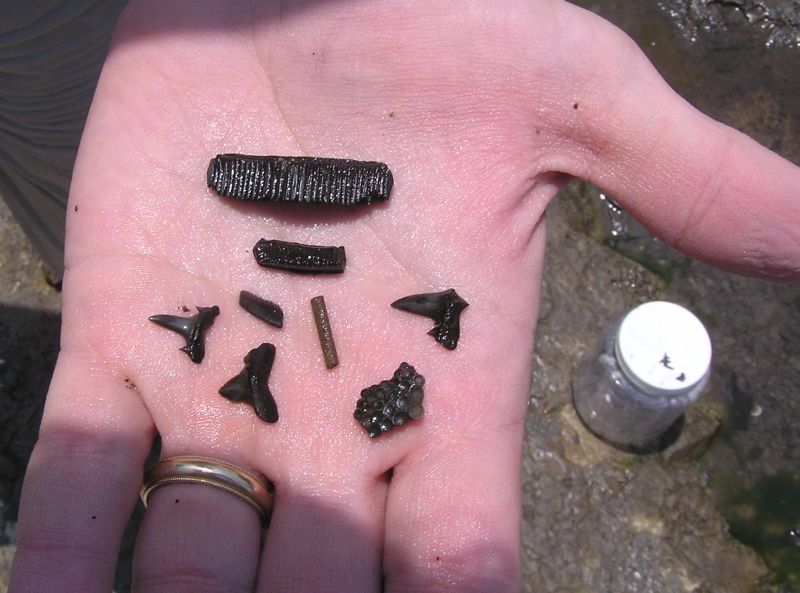
Sample of the fossils found at this site.
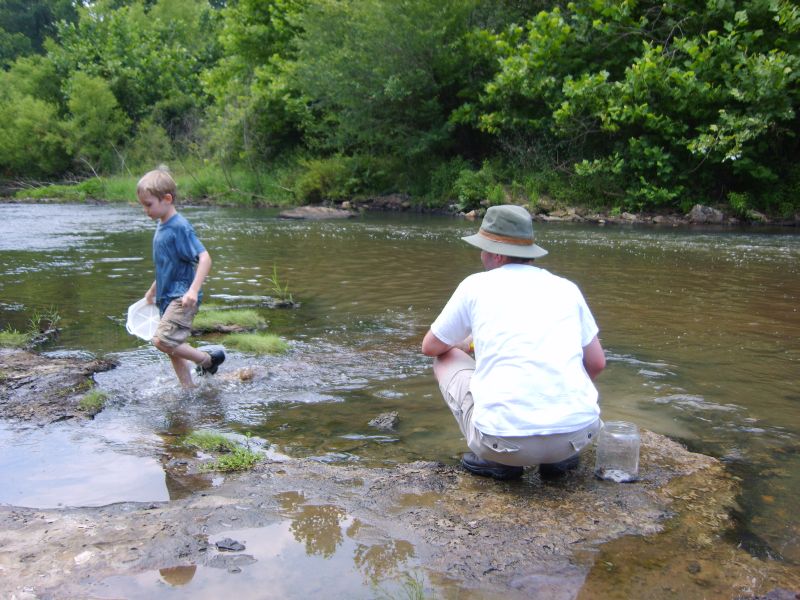
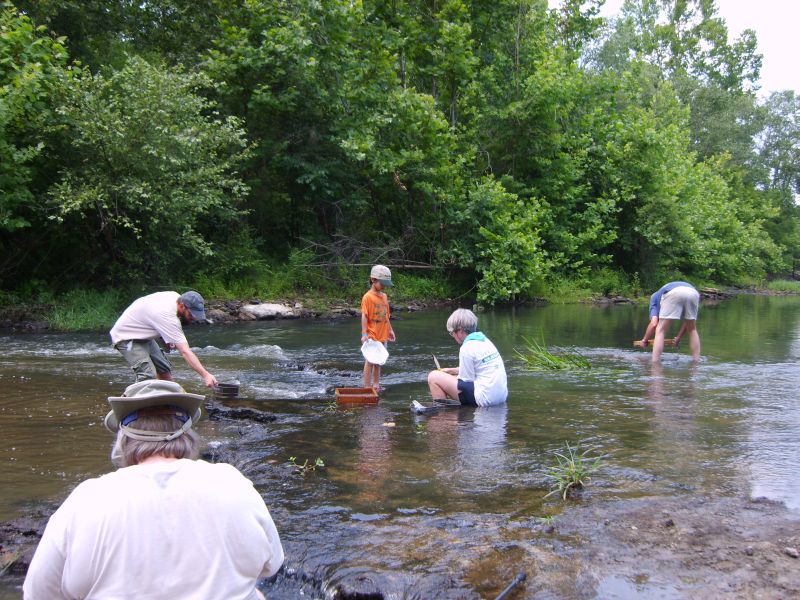
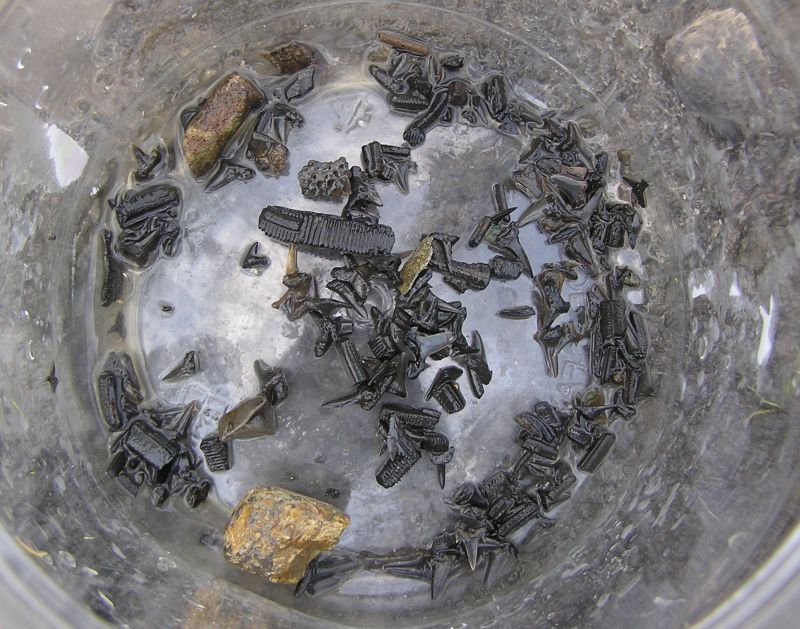
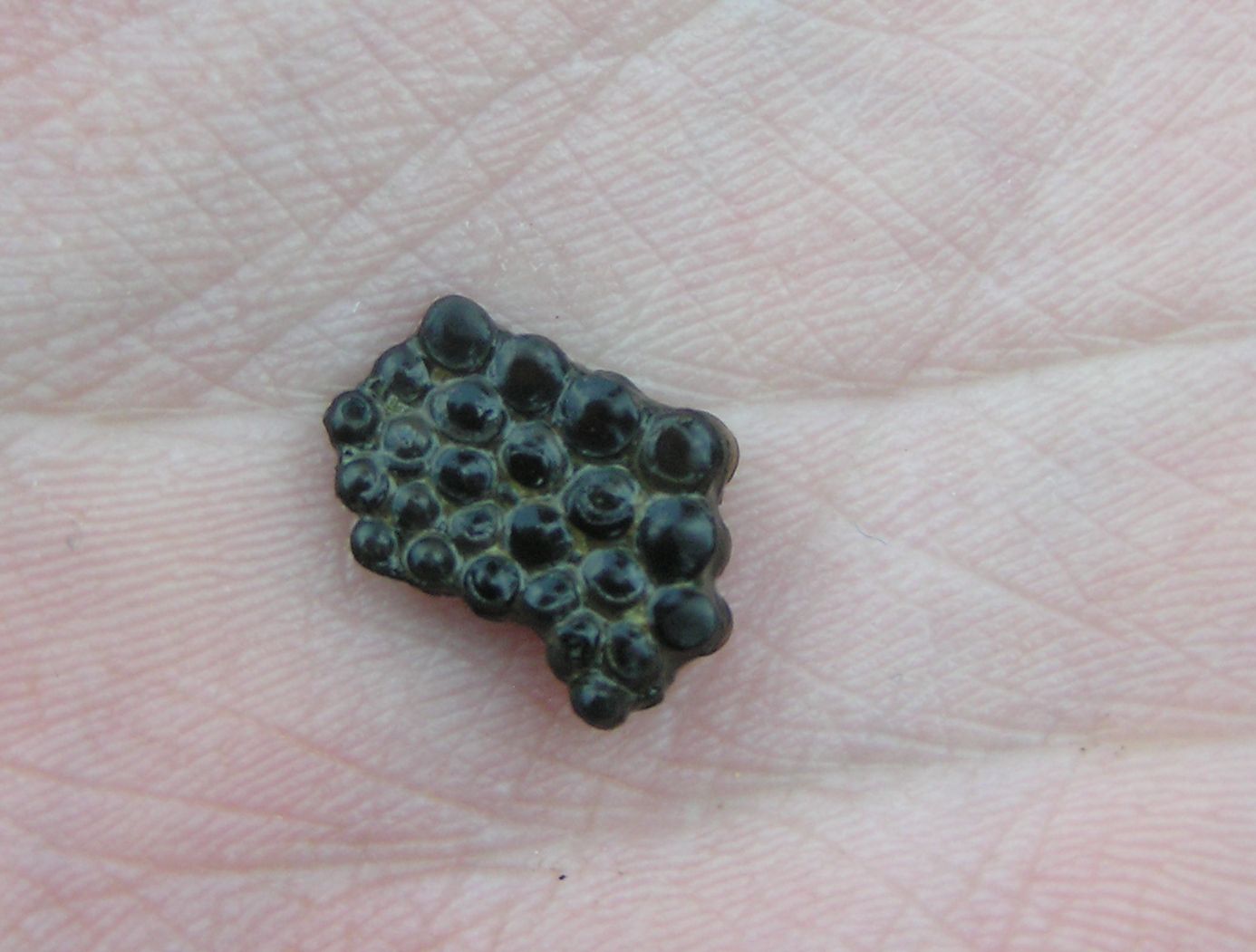
Drumfish mouth plate.
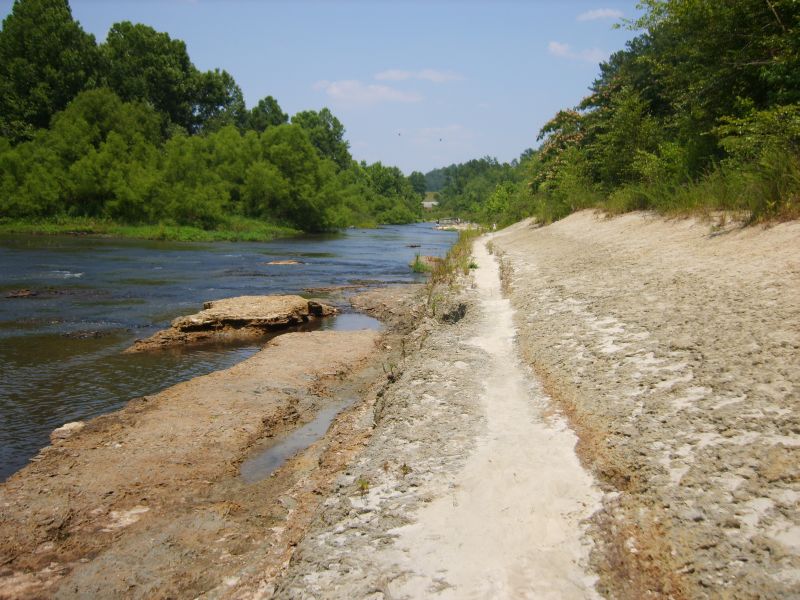
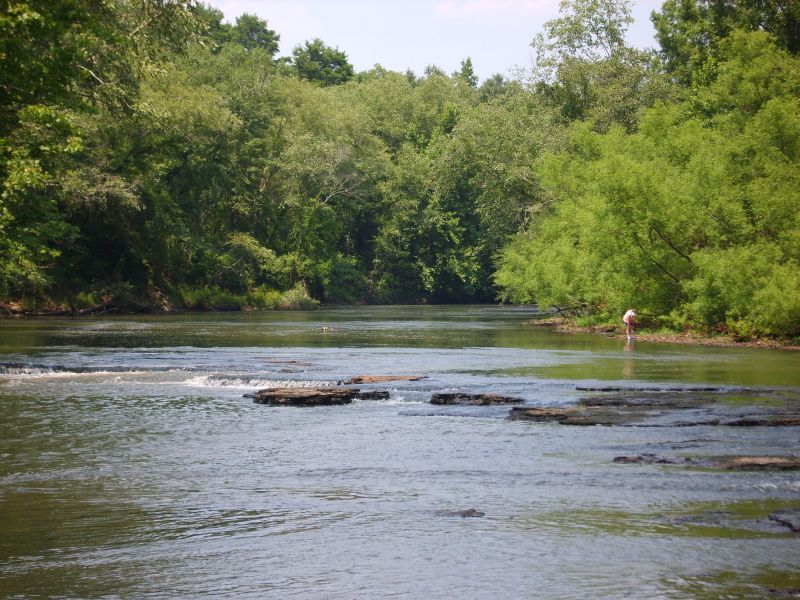
The river is low enough to expose this small waterfall, where, rumor has it, Claire and Becky engaged in a water battle.
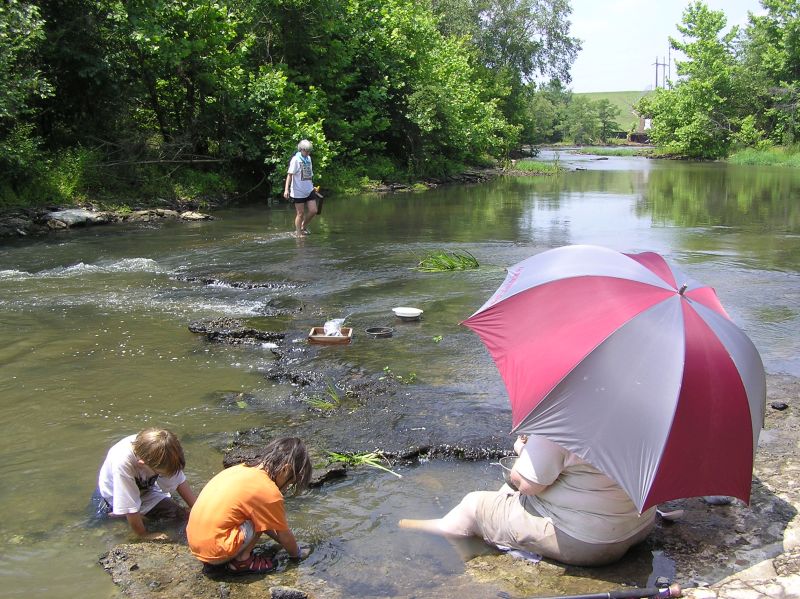
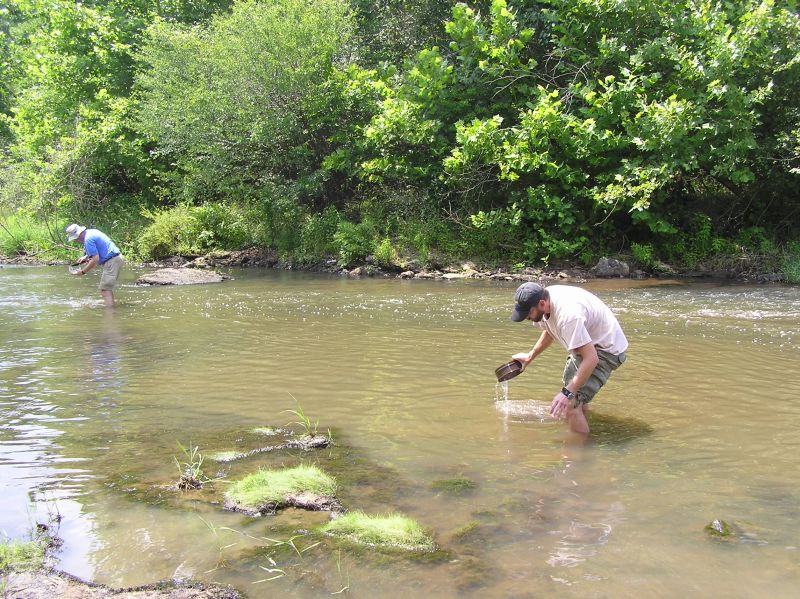
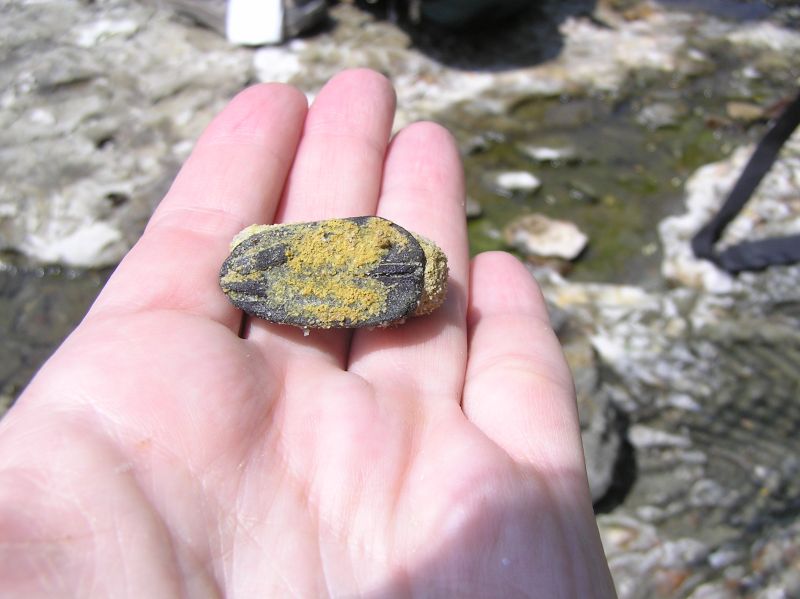
Good view of the seed found by Jan.
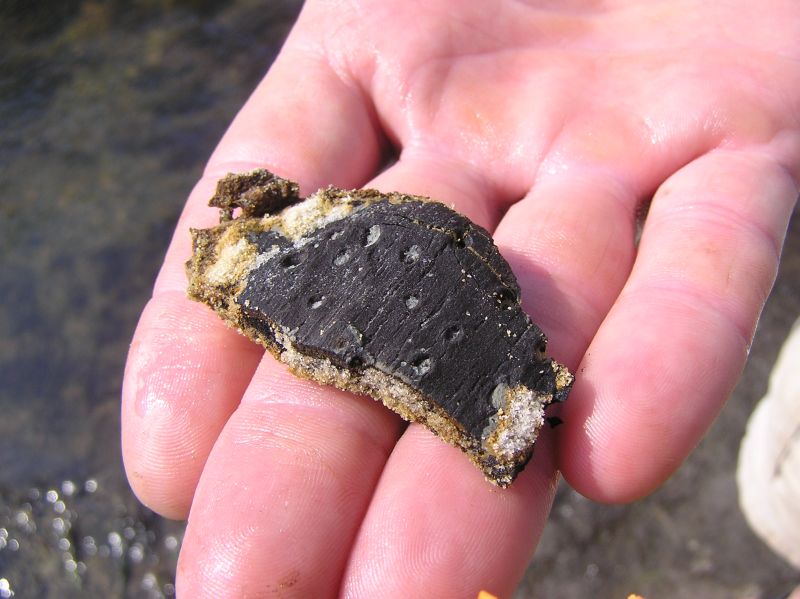
Wood found by Jan.
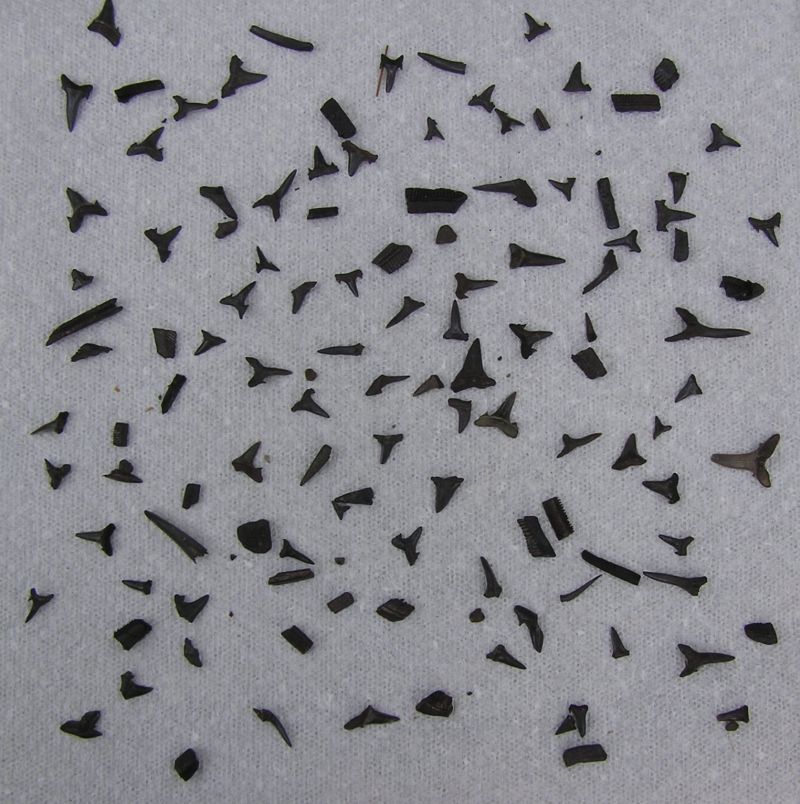
That evening at camp, we spread out our finds for the day.
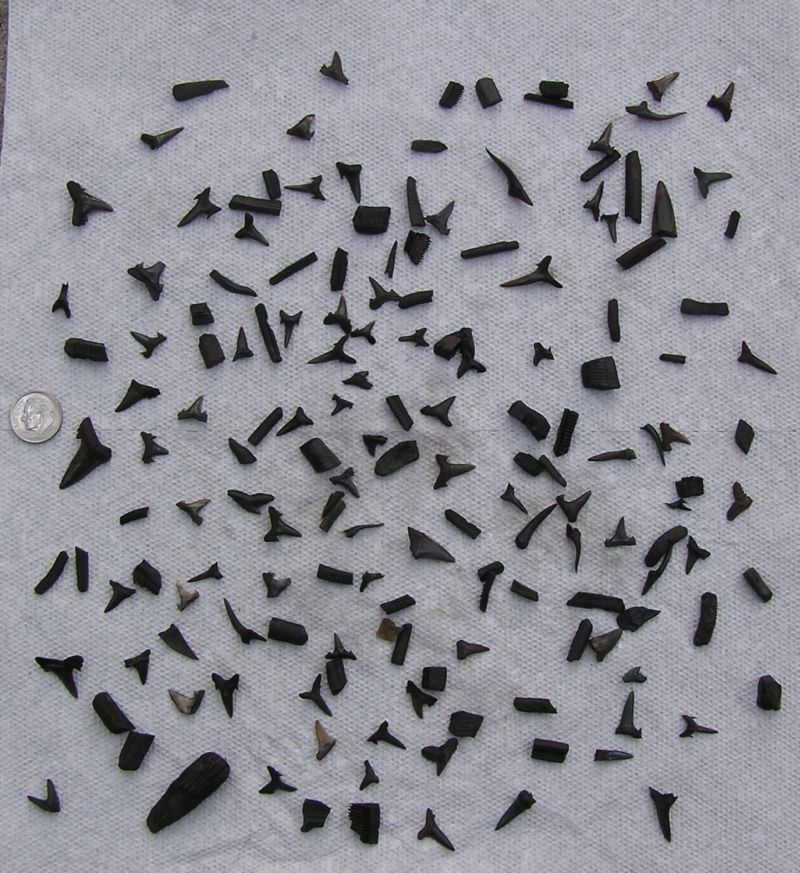
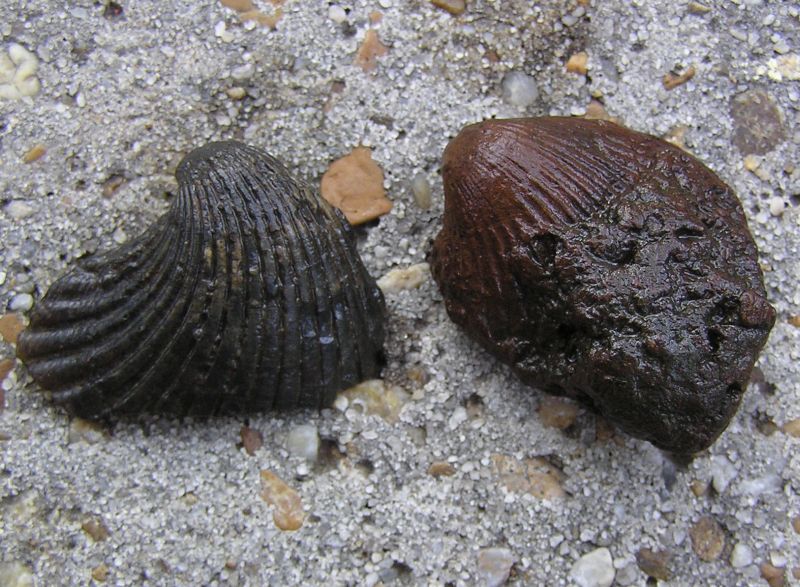
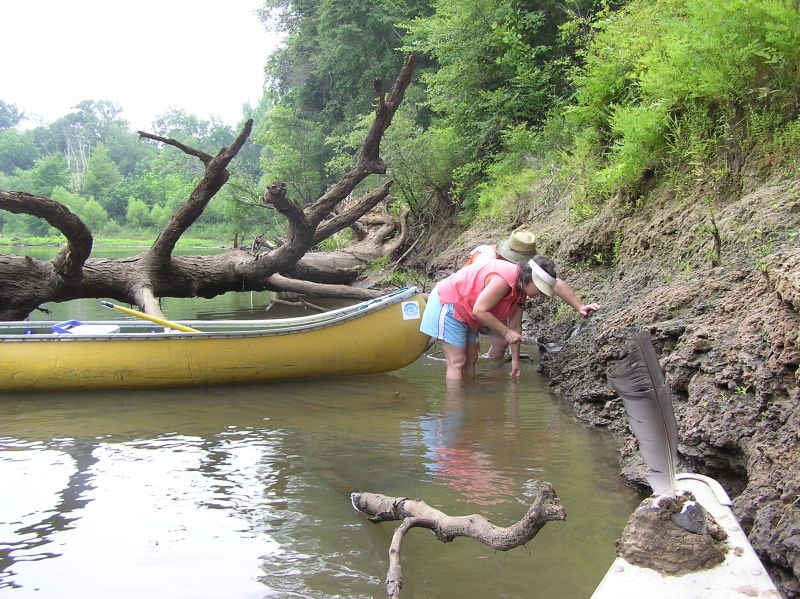
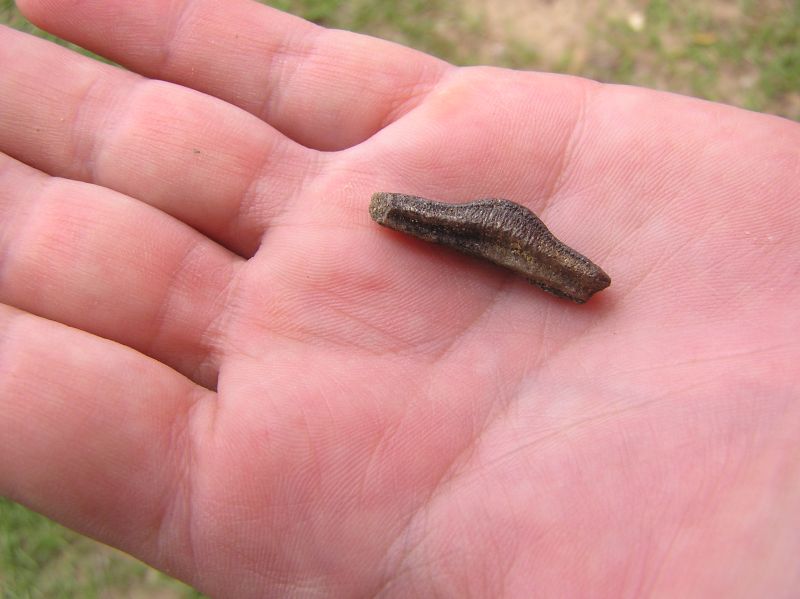
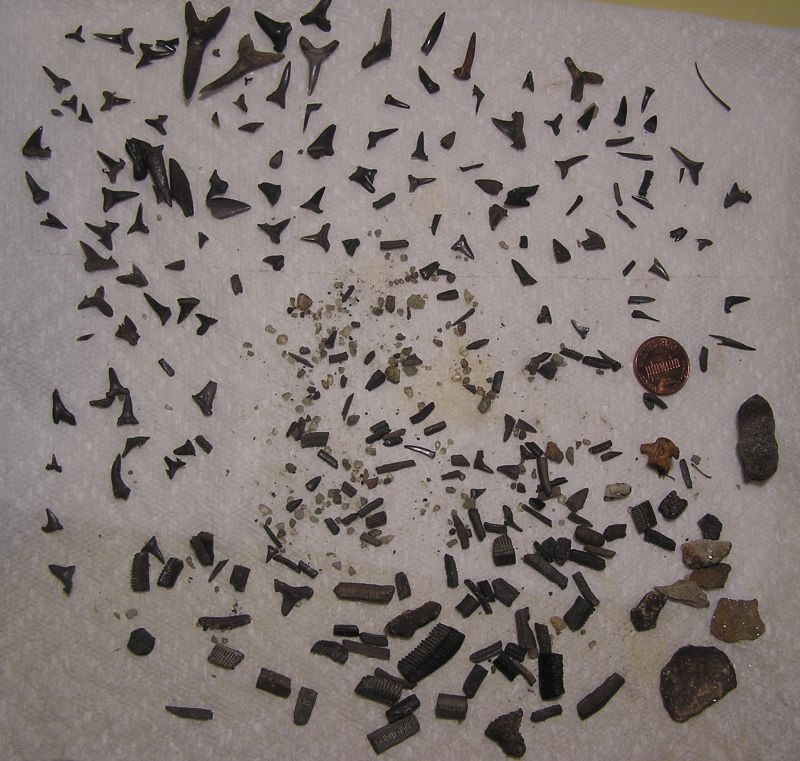
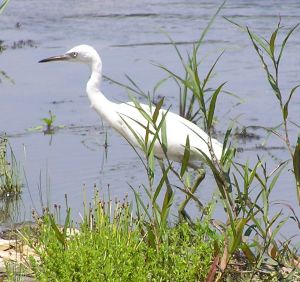
May 19, 2007 - Cretaceous Fossils, Montgomery Co, AL
Large Cretoxyrhina mantelli (Ginsu shark) tooth
Small pycnodont fish tooth - Genus Anomoeodus.
Small pycnodont fish tooth - Genus Anomoeodus.
- ‹ previous
- 6 of 9
- next ›
April 21, 2007 - Cretaceous and Tertiary Fossils, Butler Co, AL
Everyone met at a central location, and a brief introduction to the geology of the area was given before driving about 12 more miles to the entrance to the site. While past trips to this location have found the entrance roads to be very slick from rain, this years access was dry and easy. The entire caravan was able to drive to the limestone hilltop parking area.
The fossil hunting started the moment you exited your car with small gastropods and segments of large ammonites being found on the cleared hill top. The trail down to the creek provided more ammonites.
The creek was beautiful with white quartz sand beaches at many of the bends. Shark teeth, ray teeth, fossil bone, ammonite pieces and nautiloids were found in the gravel bars, along with numerous non-fossilized bones and teeth from various mammals. Some of the more interesting finds were various human artifacts rather than fossils. Indian potshards, some with incised decorations, a couple of projectile points and an Indian pipe, probably of European origin, were found.
The end of the day found the diehard fossil hunters resting at the beach where the trail intersected the creek. The Novaks organized a fire on the beach to roast small sausages, while others brought snacks to contribute, and the Stewarts returned to the parking area to set up camp for the night and fix their dinner.
By dark, everyone headed home, leaving Pam and Bob to enjoy a pleasant night at the site with owls hooting and Whip-poor-wills calling. At daybreak turkeys could be heard at the tree line adjacent to the camp area. After a couple of hours of walking the creek on Sunday morning the Stewarts packed up and reluctantly left the site, letting it return to nature.
(Photos courtesy Jan Novak, Bob Stewart, Becky Guthrie, and Vicki Lais)
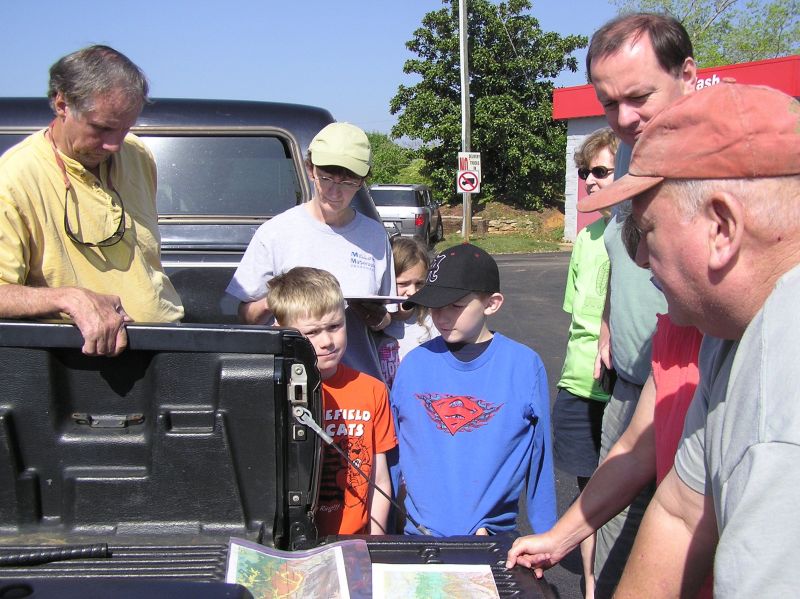
Vice President Greg gives an overview of the geology of the site and collecting rules.
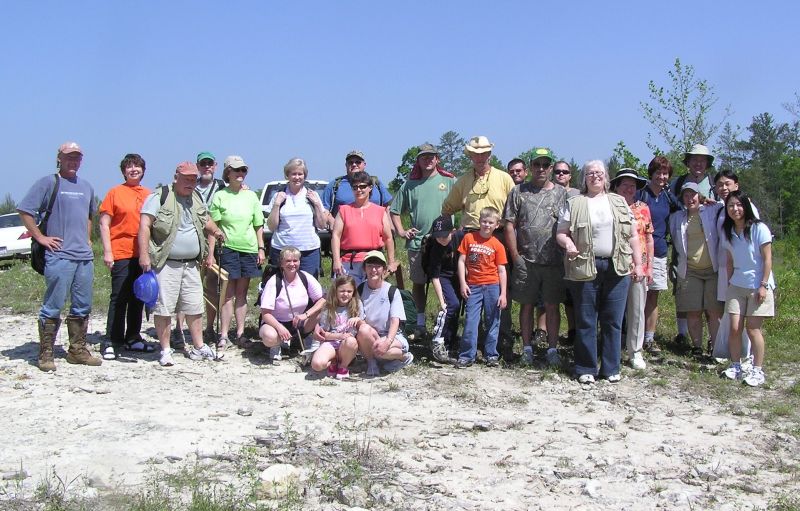
A lot of excited people showed up for the field trip - fossils can even be found on the limestone earth in the foreground.
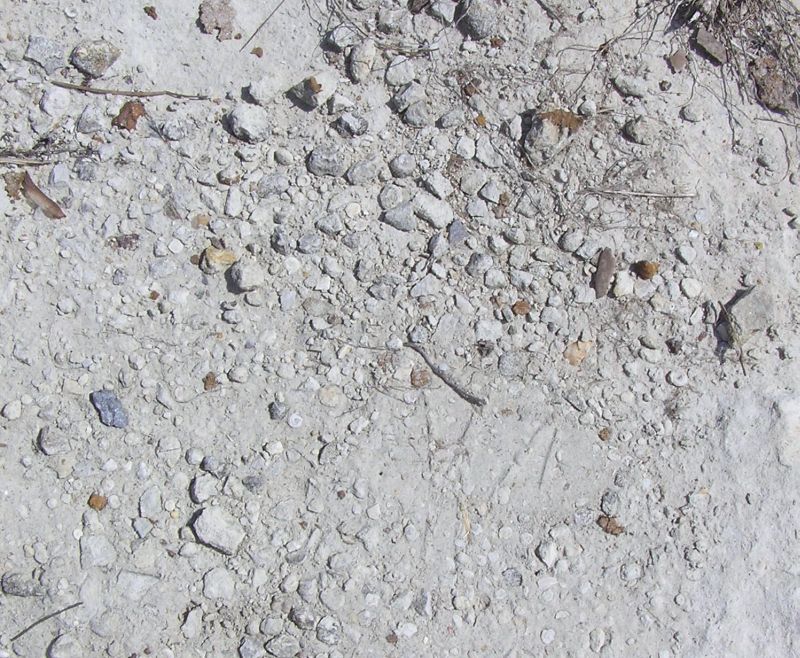
If you look carefully, you can spot tiny round gastropods, each approximately 3/8 inch across.
Hiking down to the creek from the parking area (and of course, looking for fossils along the way!)
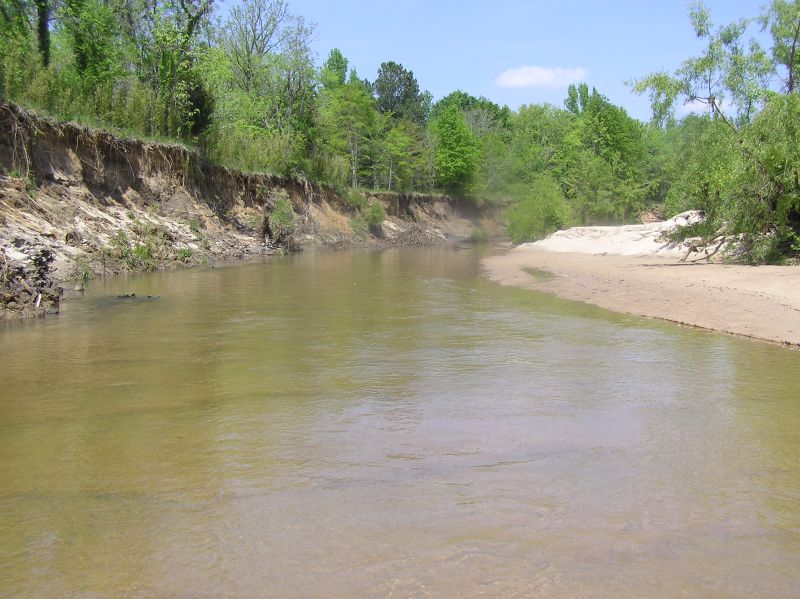
The creek was higher this year than normal, but there were still numerous gravel bars.
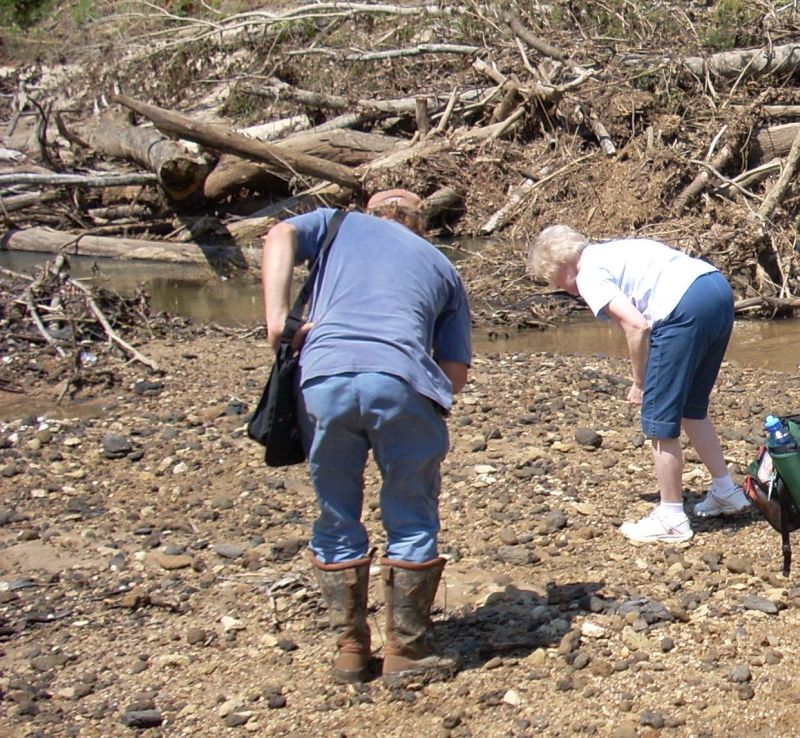
A recent storm had washed up a huge pile of brush and trees, and left behind rocky rubble and mud rather than the white sand we normally find.
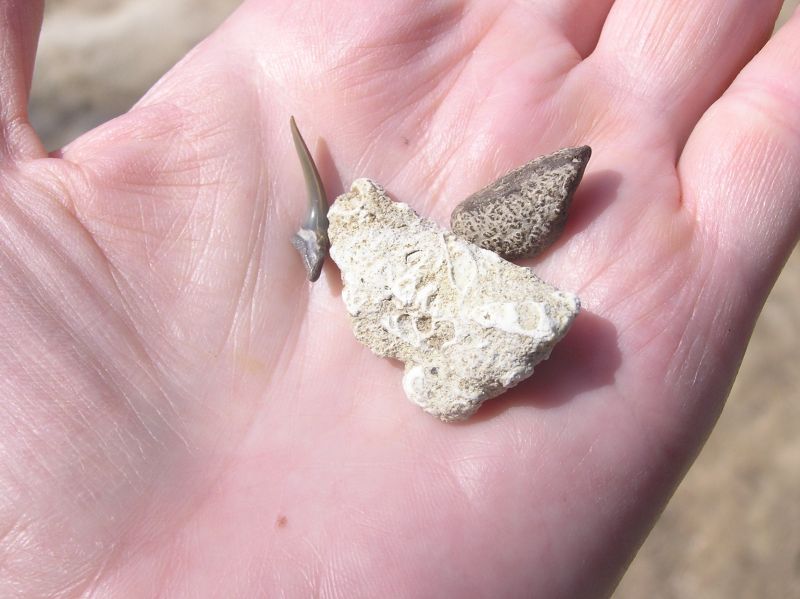
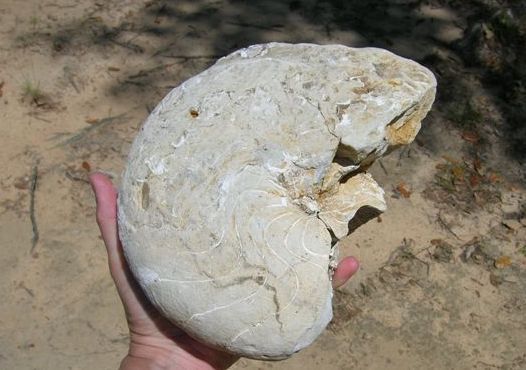
Nice nautiloid found by David.
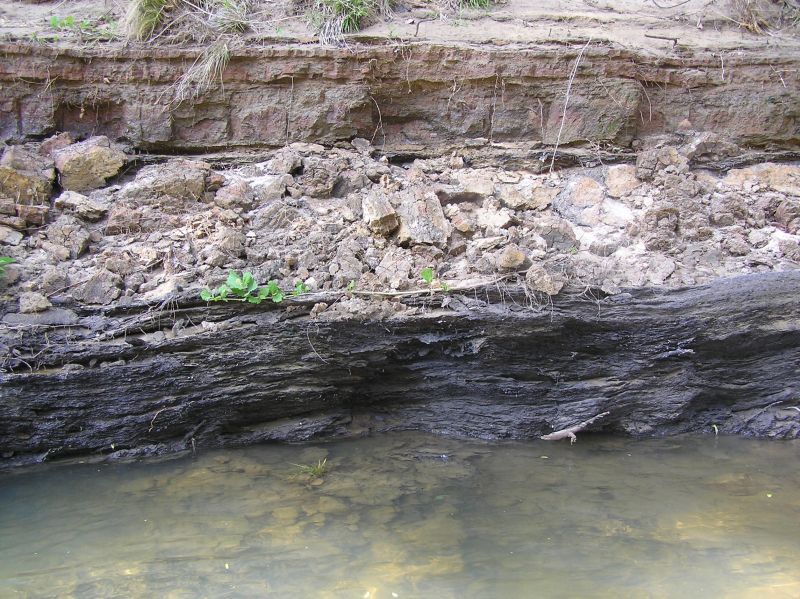
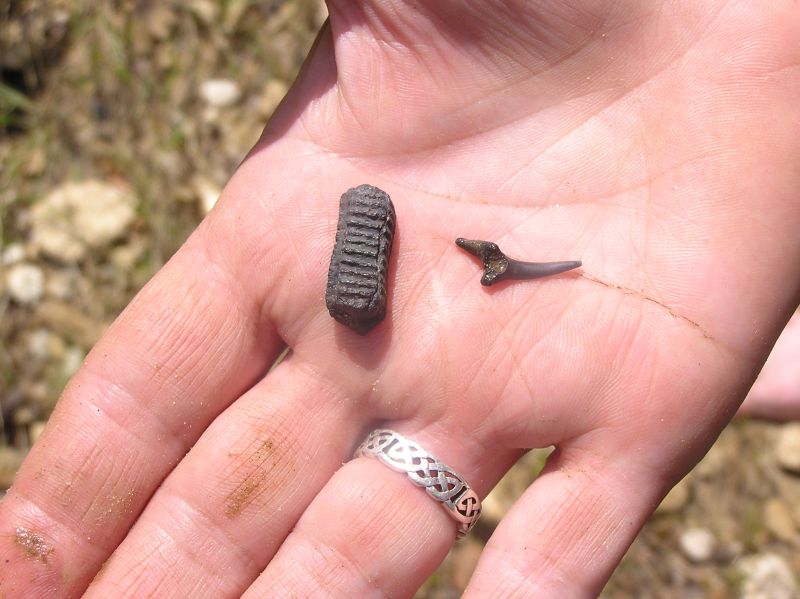
Ray tooth and shark tooth.
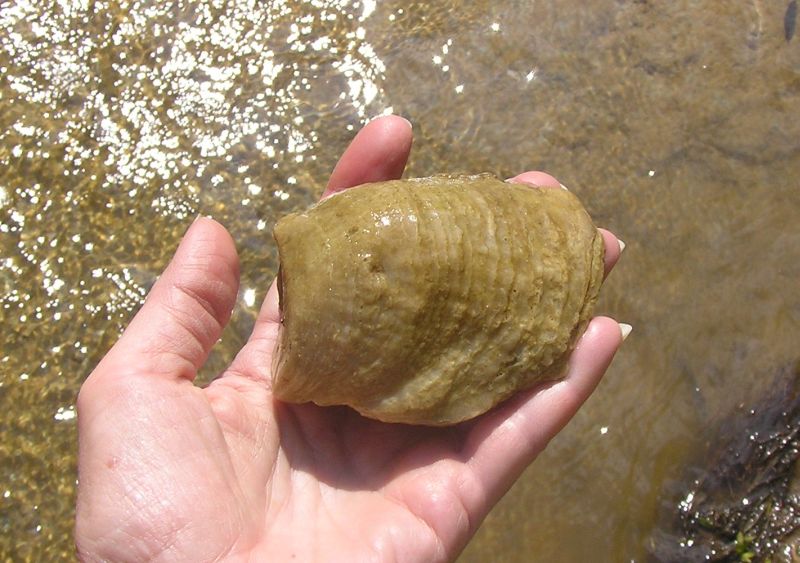
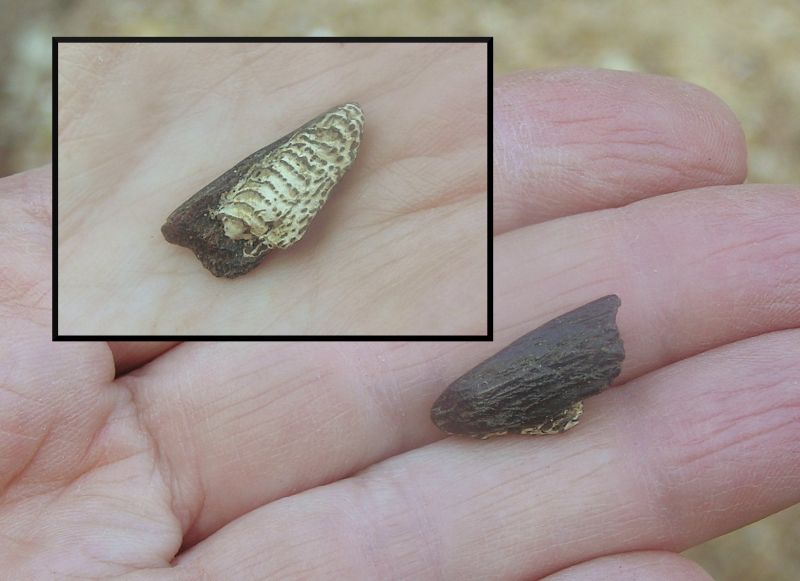
Unknown item, can anyone identify? Looks kind of like a tooth. . . .but . . . .
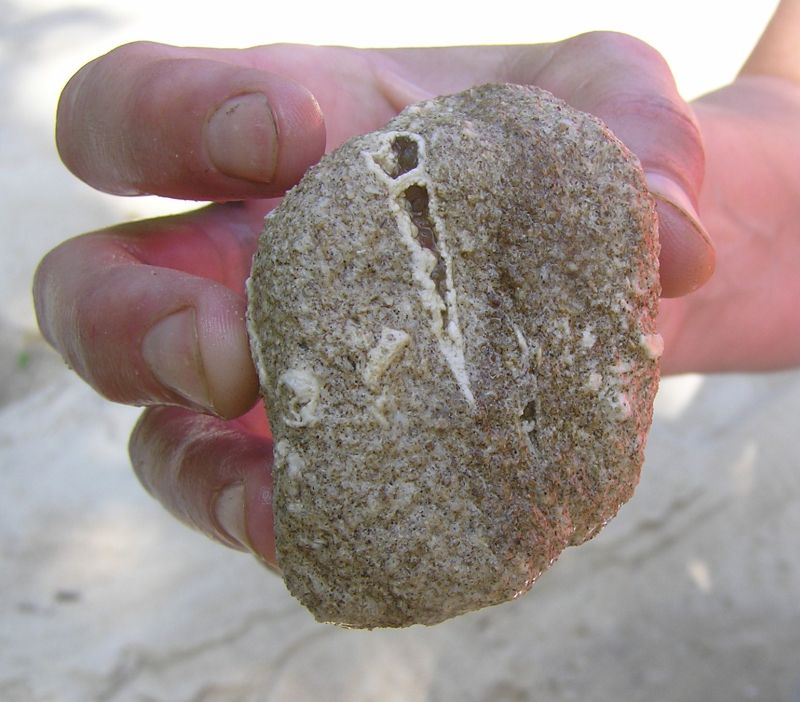
Nice turritella in coquina.
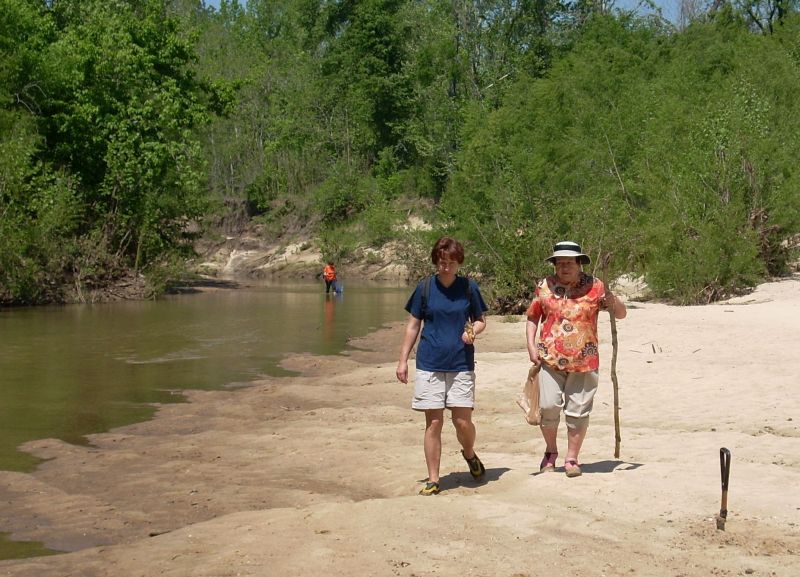
Lea's mom was visiting from the Czech Republic, and decided to join us for the fun!
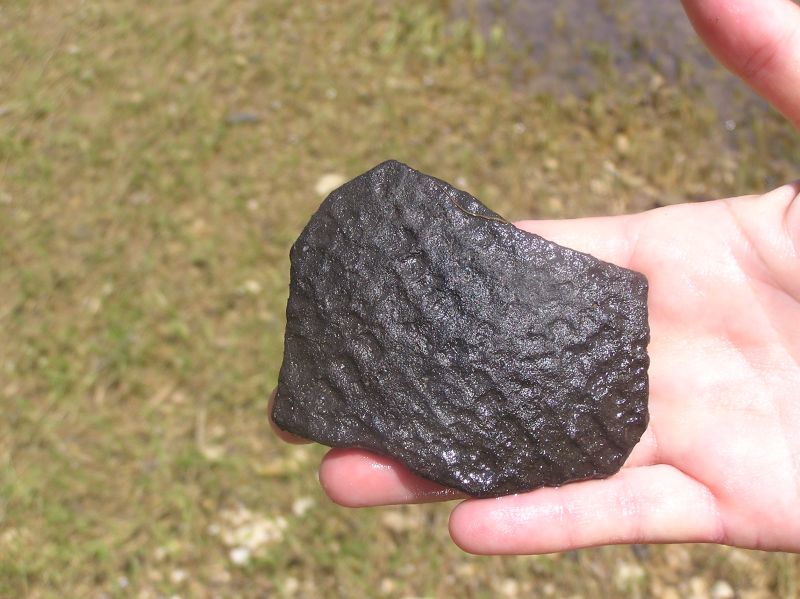
Shells in matrix.
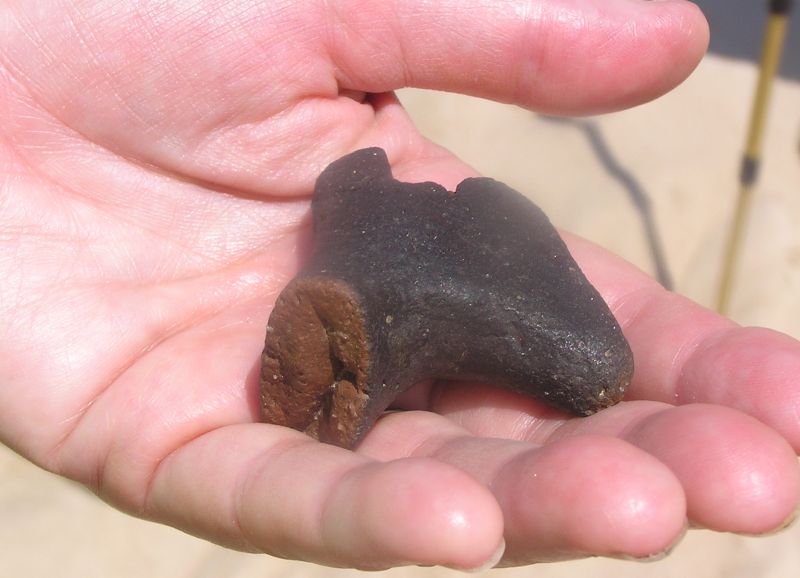
Probably a pottery handle.
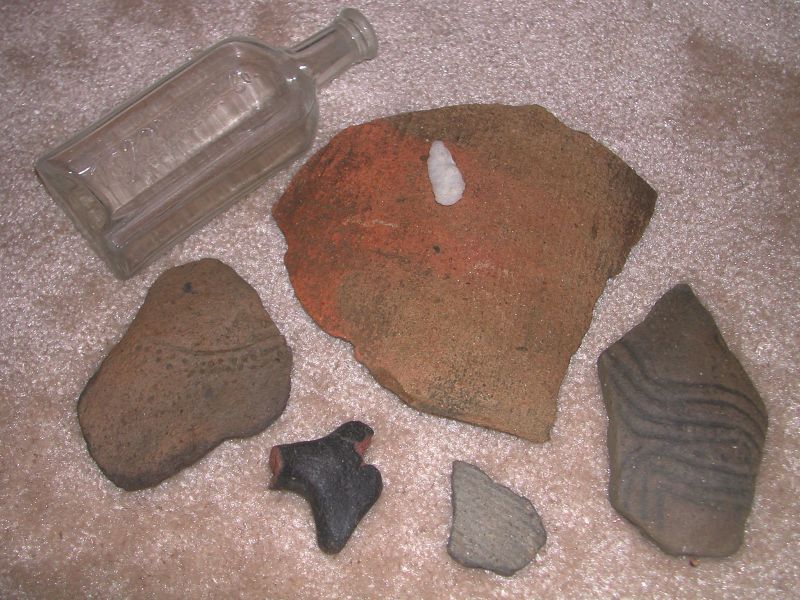
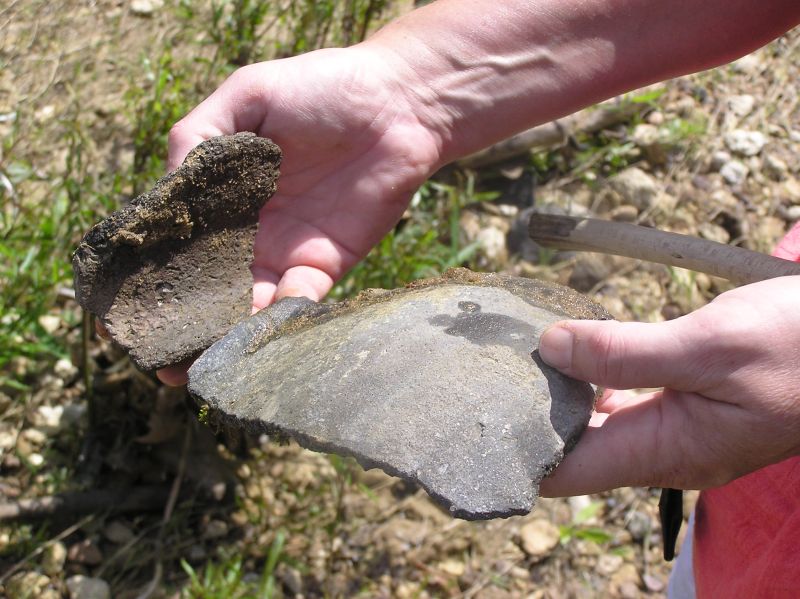
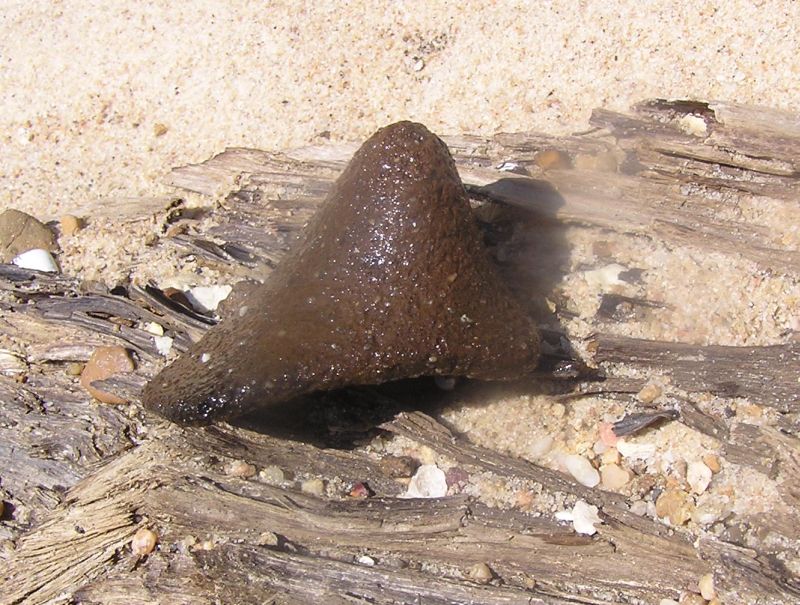
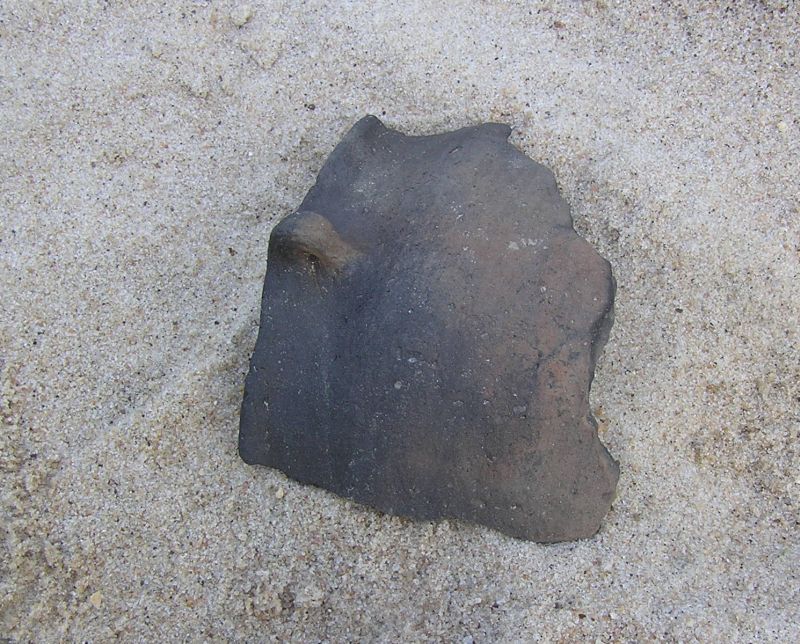
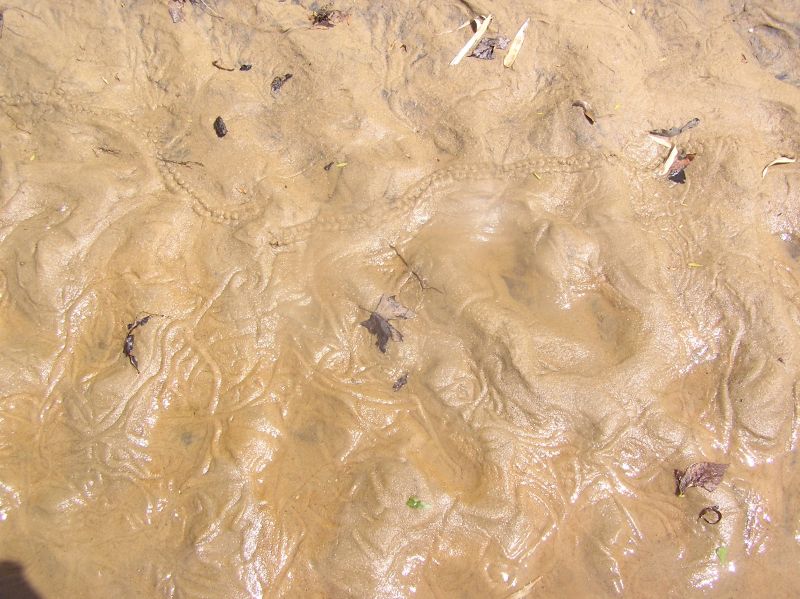
Worm tracks in the sand. Fossil worm tracks much like these are found in shale in north Alabama.
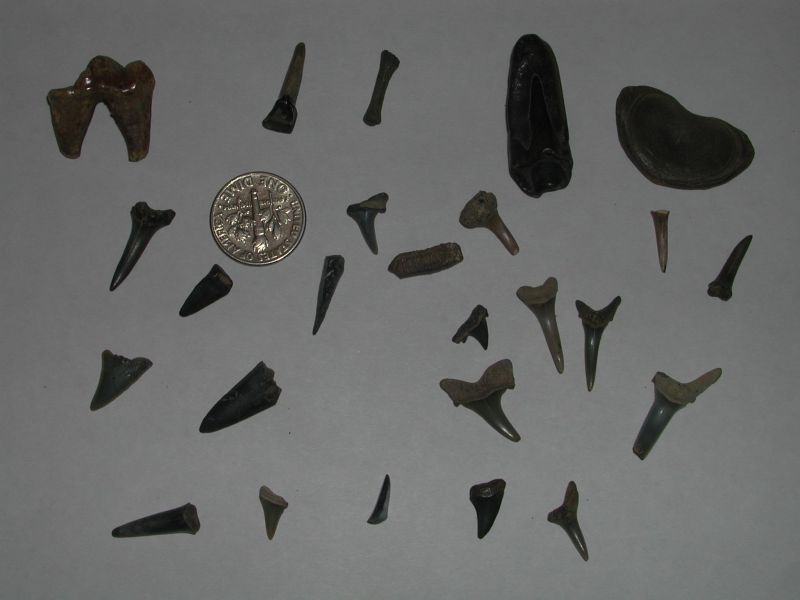
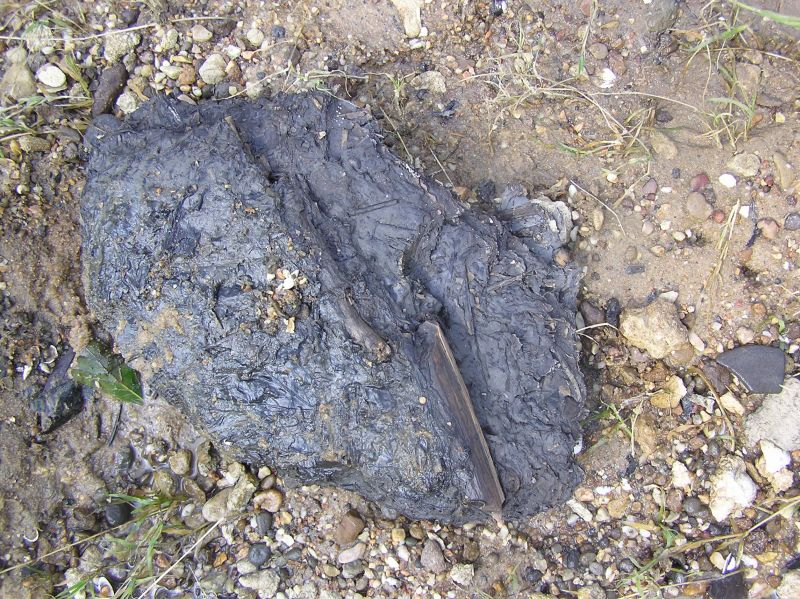
Numerous clayballs were found in the creek. This one shows bits and pieces of plant debris. The finder did not examine it closely to determine whether these were fossil leaves or recent, however, based on the geology of the area, they could easily be cretaceous fossil remains.
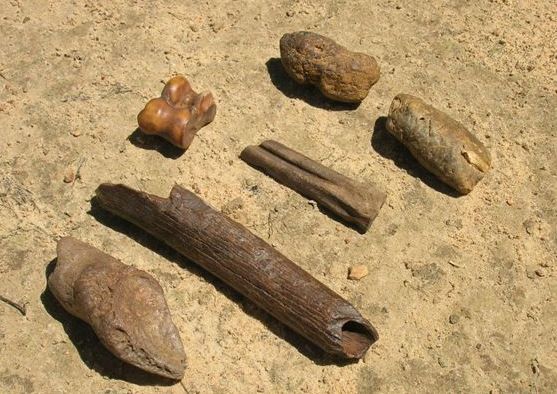
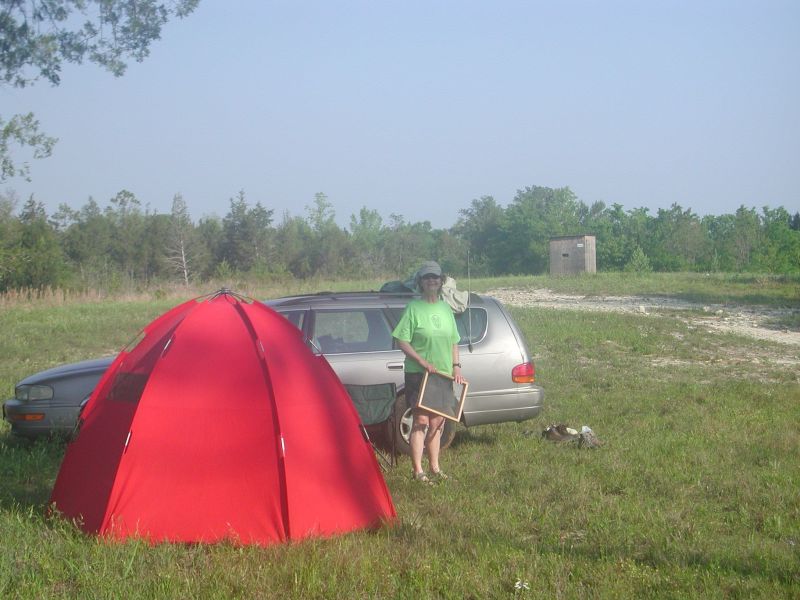
While Bob & Pam set their tent up . . .
The others built a fire and enjoyed the evening.
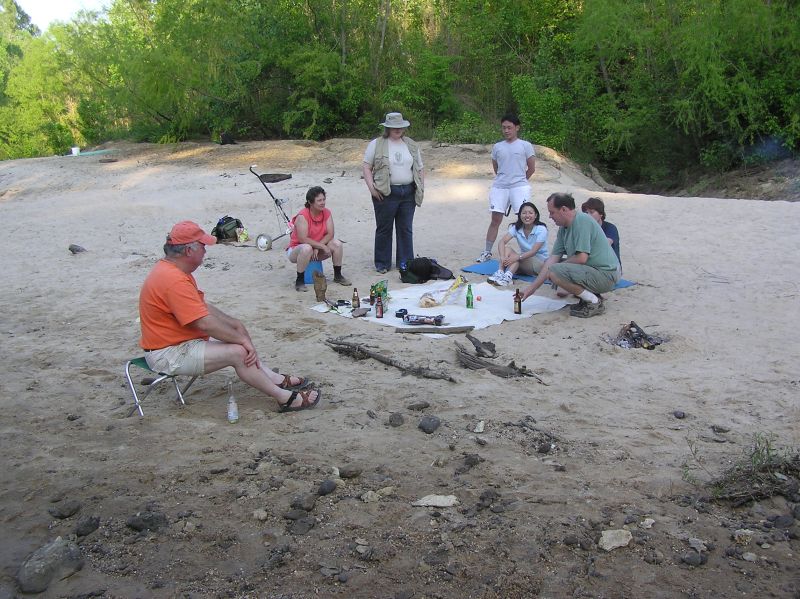
The campfire has about died out as some of the diehard fossil hounds hang out wringing that last little bit of enjoyment from the day!
June 03, 2006 - Paleocene Fossils, Clarke and Wilcox Co, AL
Today BPS went way down south to Clarke County, Alabama. We were quite excited because this was a new site Steve found, and we were chomping at the bit, ready to go. We found a good variety of bivalves and gastropods, a few shark teeth and ray teeth. The most numerous fossil we found is Flabellum cuneiforme pachyphyllum, a type of coral from the upper Lisbon formation. This is unlike any corals we have collected in the past, as it has a flattened shape, as if someone took a horned coral and squashed it. Some were tinted a pinkish color, which made them easy to spot in the mostly white matrix. At least one specimen of Endopachys maclurii was found (looks similar to the flat one, but has two bumps on each flat side), and several very tiny round specimens of Discotrochus orbignianus were found. (Specimens from this site are very fragile, and should NOT be placed in a bucket of water to clean, as they will crumble. Even the ones that look thick and solid. Brush them off dry, or very lightly wet them, then put them where they can air dry, perhaps on a wire screen.)
Later in the day we headed to Wilcox County, Alabama, to some huge road construction rubble piles. These rocks were from the Paleocene, Midway Stage. Several nice nautiloid casts (Hercoglossa ulrichi) were found at this site, as was an extremely nice vertebra, which has not yet been identified. The nautiloids are made of compressed sand, and the actual shell has disintegrated. Though they are very heavy and appear sturdy, if left exposed to the weather, or cleaned with water, they will crumble into a pile of sand.
Update: July, 2006 - on the trip, Martha found a large bone that appeared to some of us to be recent, as it was very lightweight; however, Jun Ebersole and James Lamb of the McWane Science Center asked to examine the bone, and determined it is from the only early whale of this species ever found in the state. The specimen has been sent to an early whale expert for study.
(photos courtesy Steve Corvin and Vicki Lais)
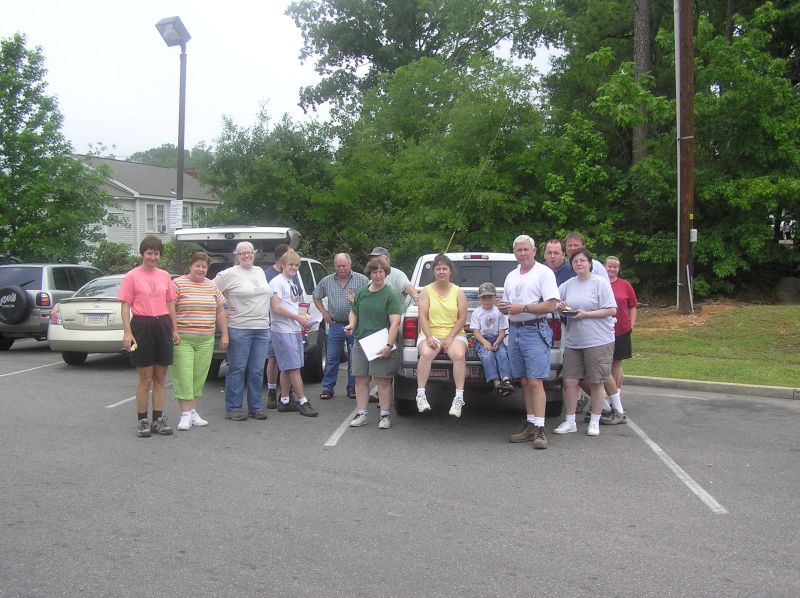
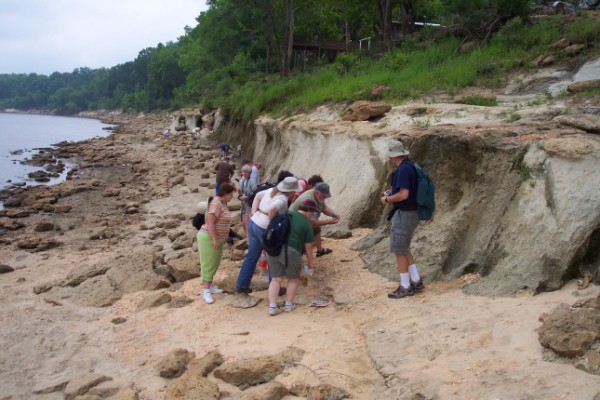
Greg is showing the group some specimens from this site - nice corals.
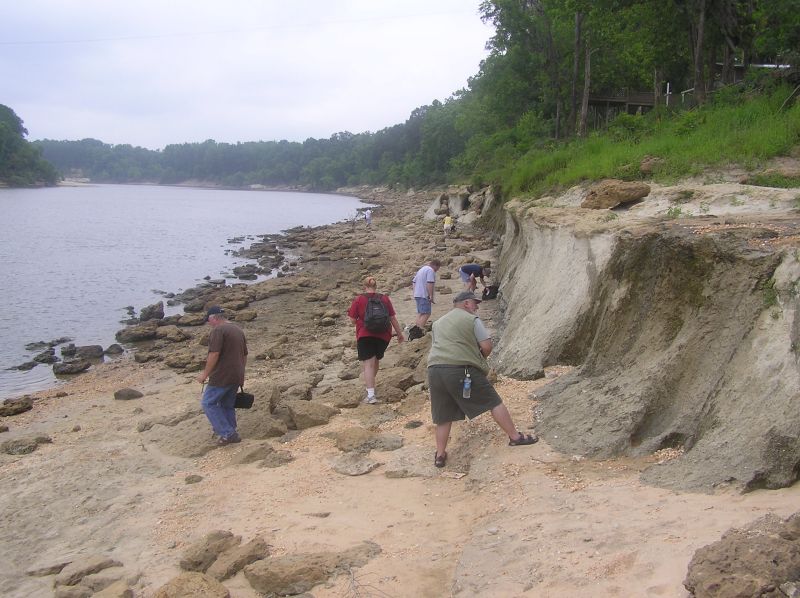
And the group scatters - the low water level makes hunting easy.
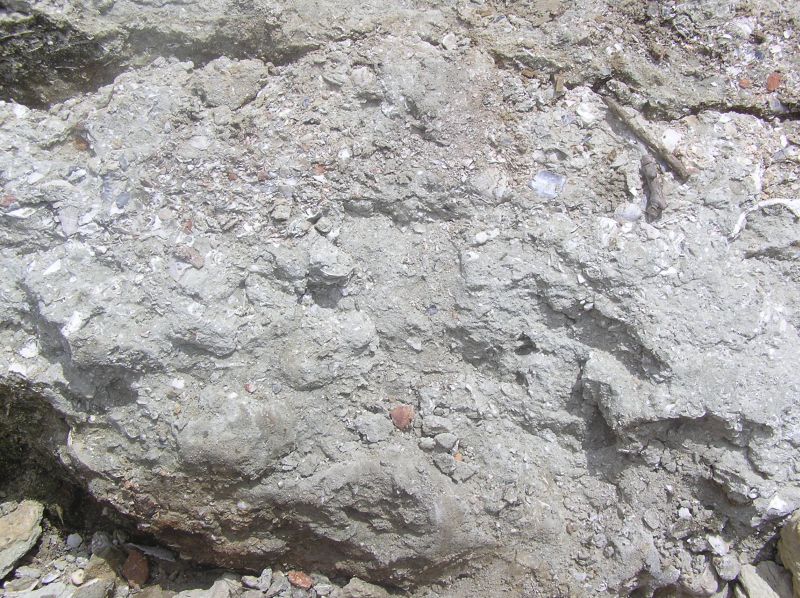
All the rocks at this site are filled with shells and corals. The trick is getting them out whole, as they easily crumble.
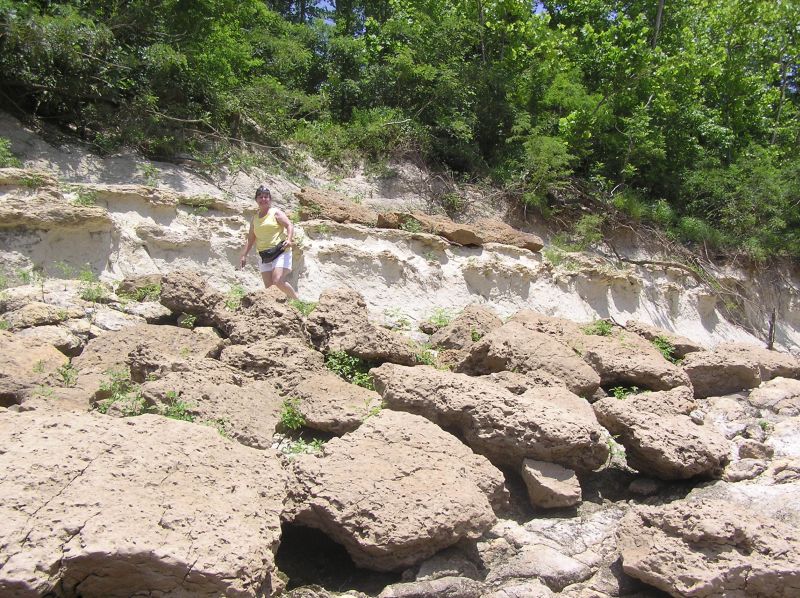
Becky is looking high . . .
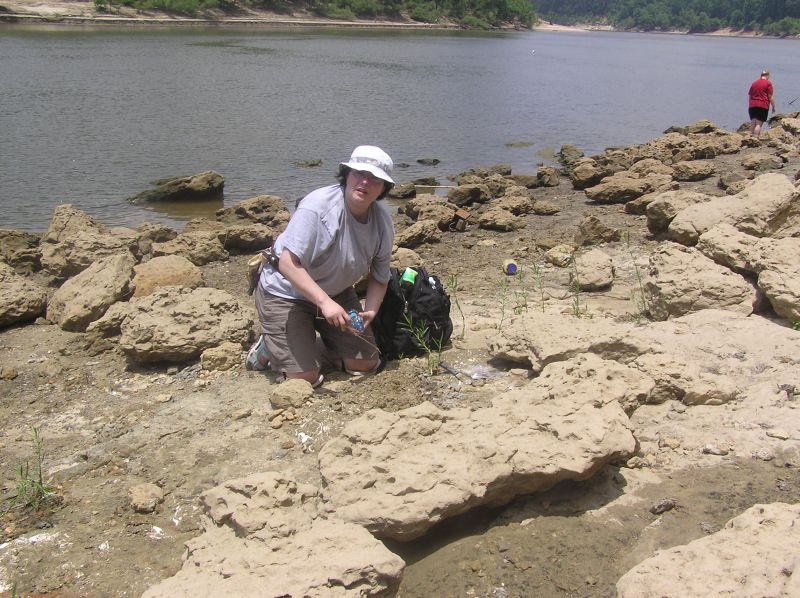
and Anca is looking low!
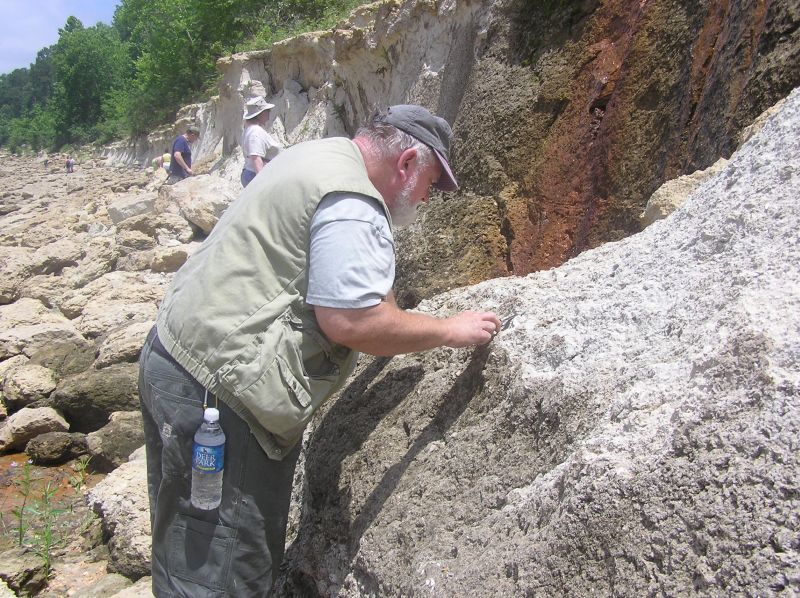
Greg carefully easing out a small coral.
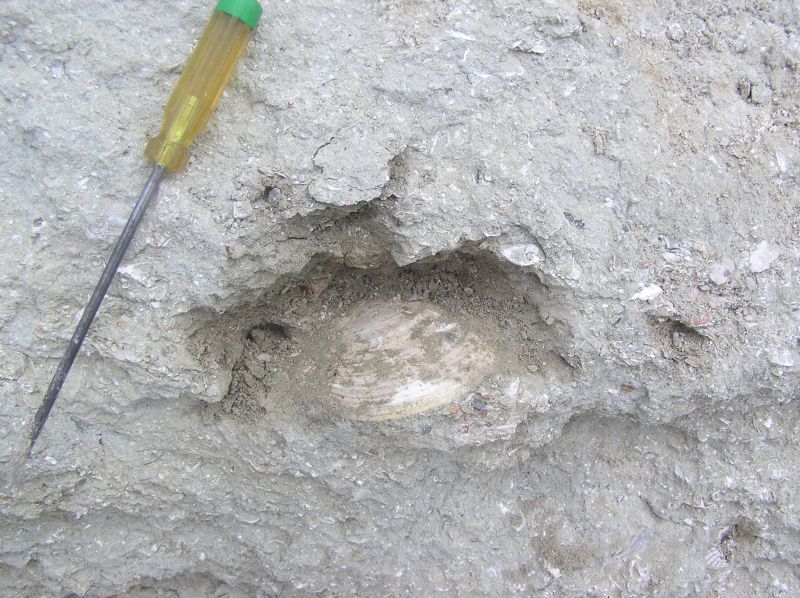
A nice bivalve found by Vicki.
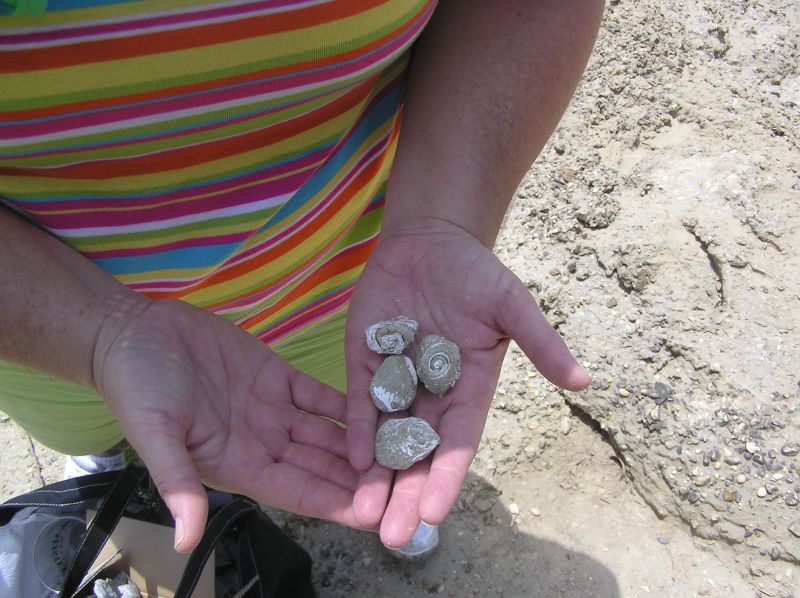
Nice gastropods found by Leisa.

A large piece of bone found by Martha. According to James Lamb, it appears to be another bone fragment from an early whale found in this area. This specimen has been sent to an early whale expert for study.

David is heading to another location. The corals and shells were found from the bluffs to the waterline, while Steve engages in his favorite activity, getting wet!
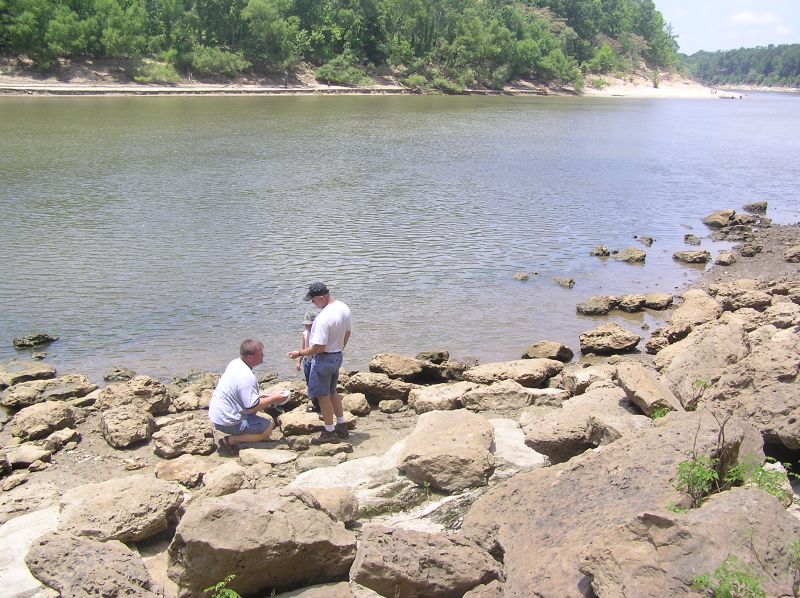
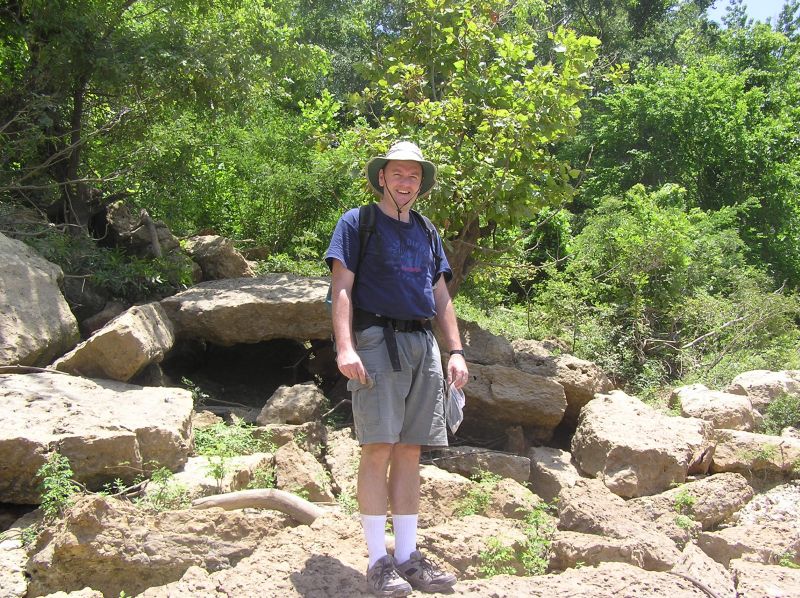
Jan, look over here!
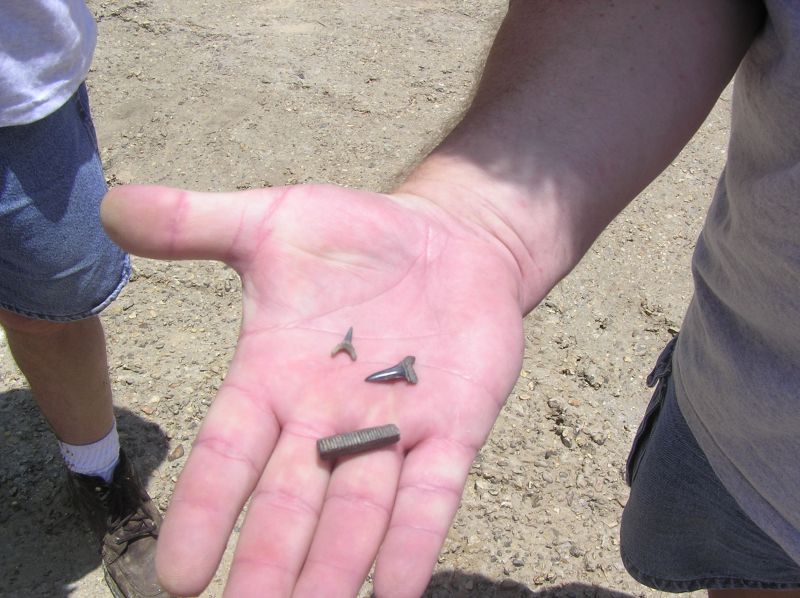
Shark teeth and a ray "tooth".
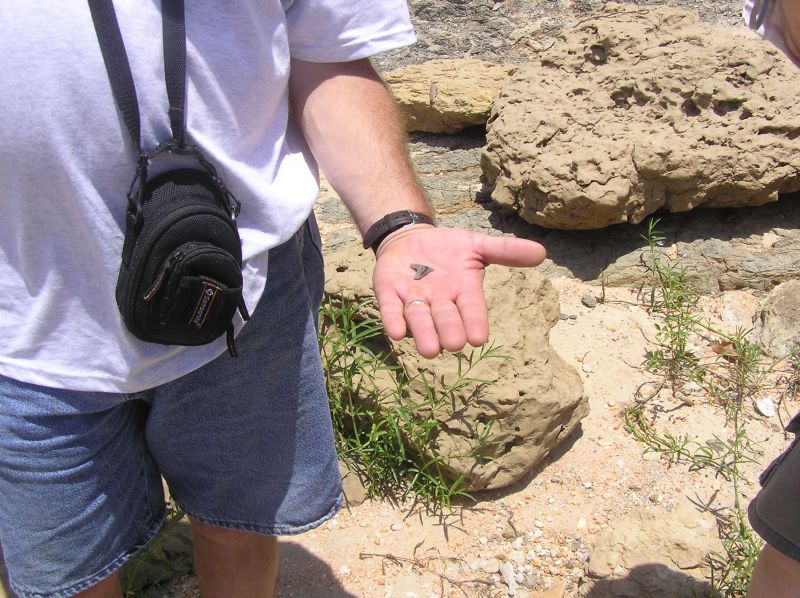
A nice larger shark tooth found by Steve.
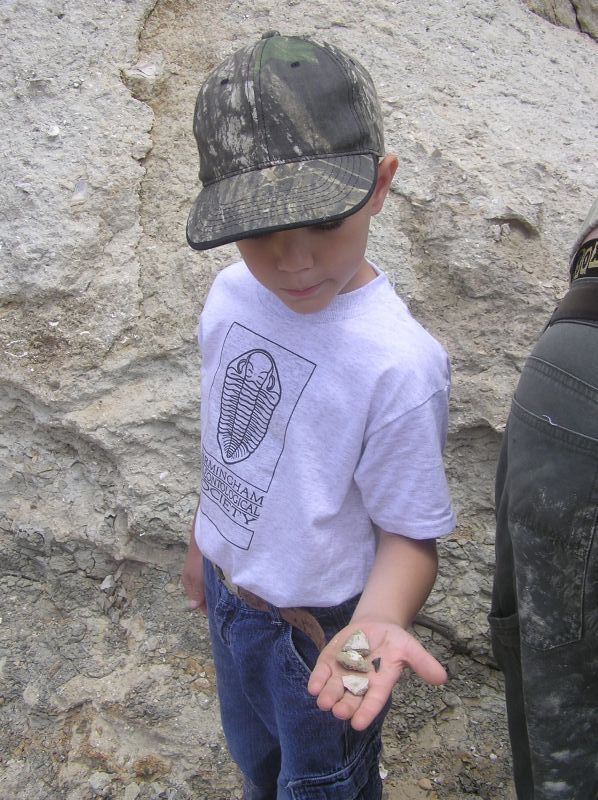
Steven has found coral and a shark tooth.
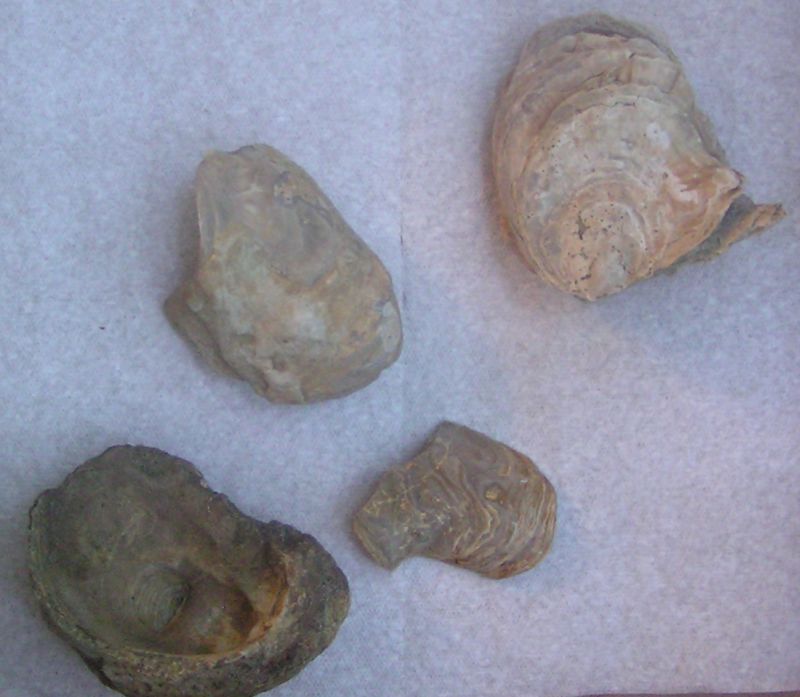
Some shells found by Vicki.
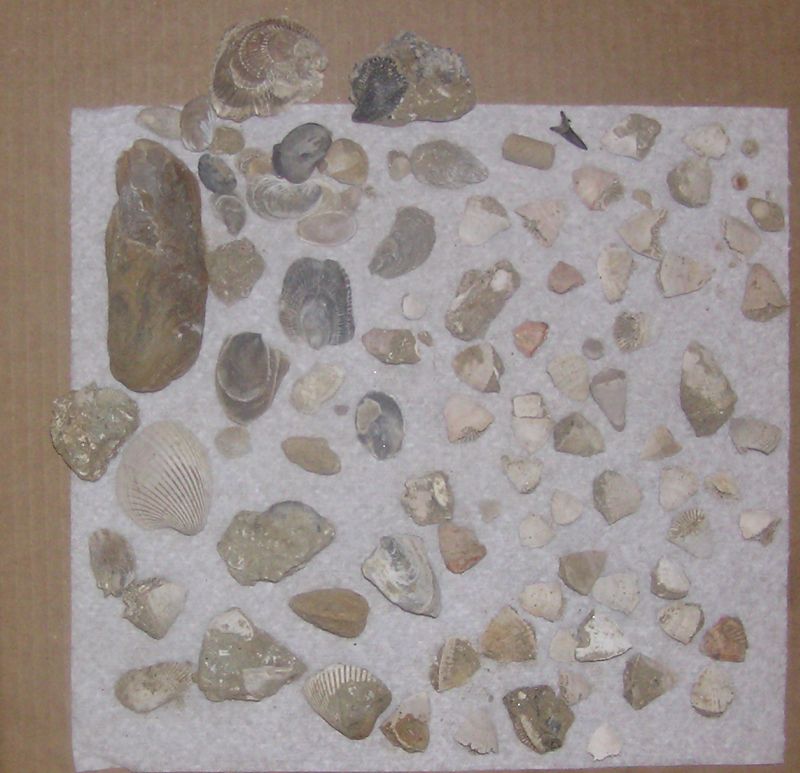
Shells and corals in Vicki's bag.
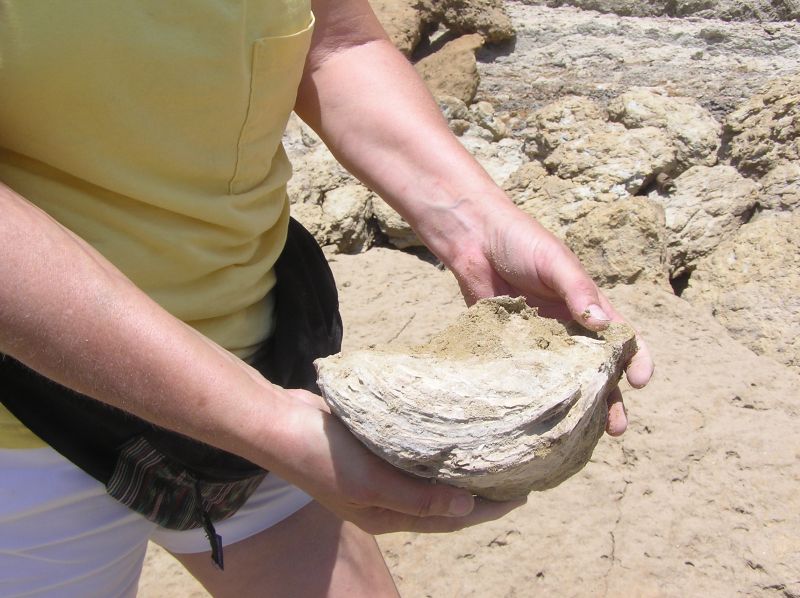
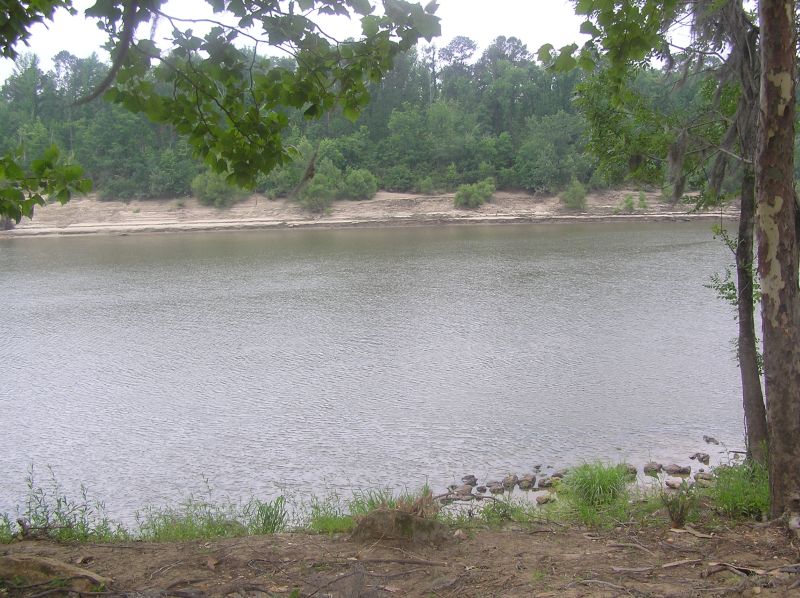
One last look at the river before we head for lunch, then on to the next site.
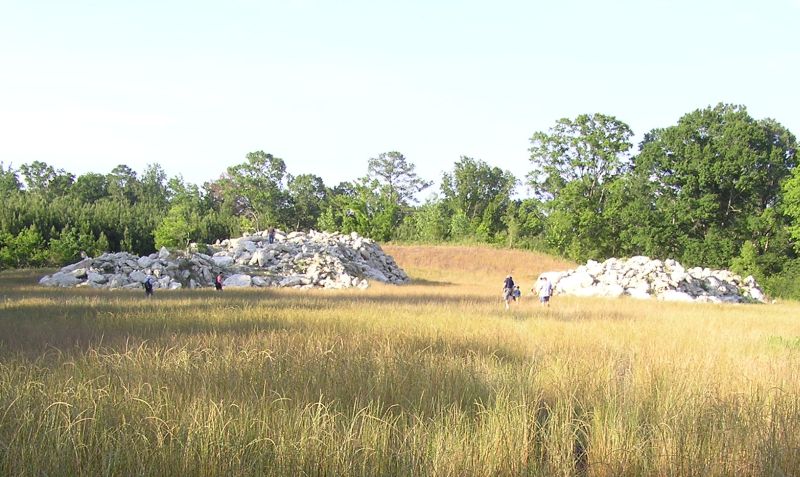
Later in the afternoon we headed north to Wilcox county, to this pile of rocks from nearby road construction.
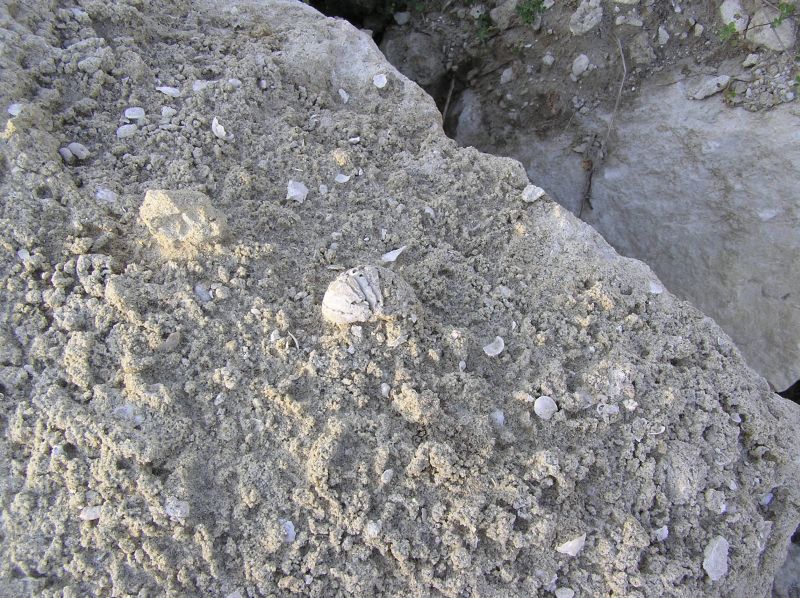
This was spotted on the way in, but the rock was too hard to easily remove the fossil.
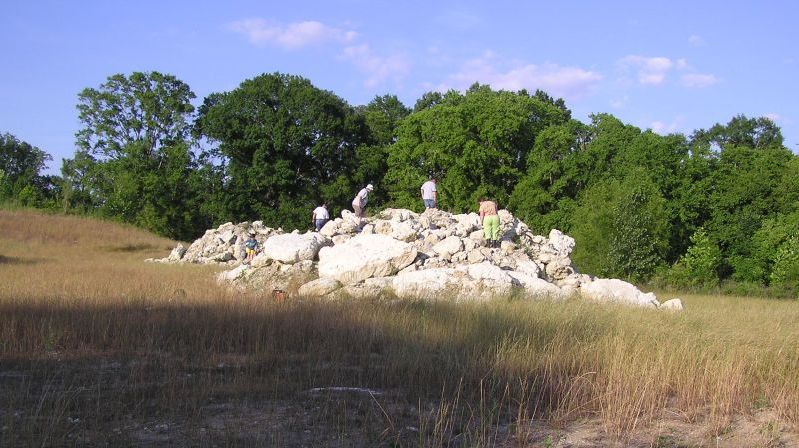
Jan and Lea headed over to this pile of rocks where they found . . .
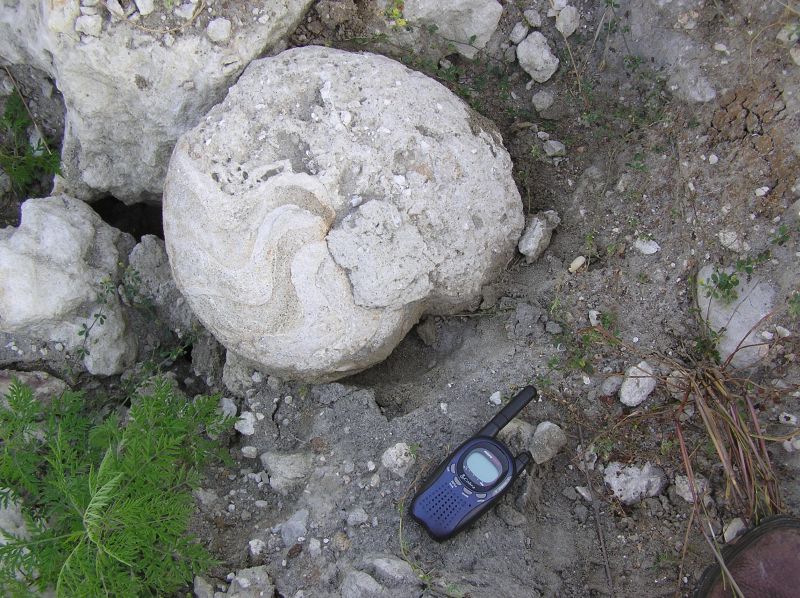
a cast of a very large nautiloid!
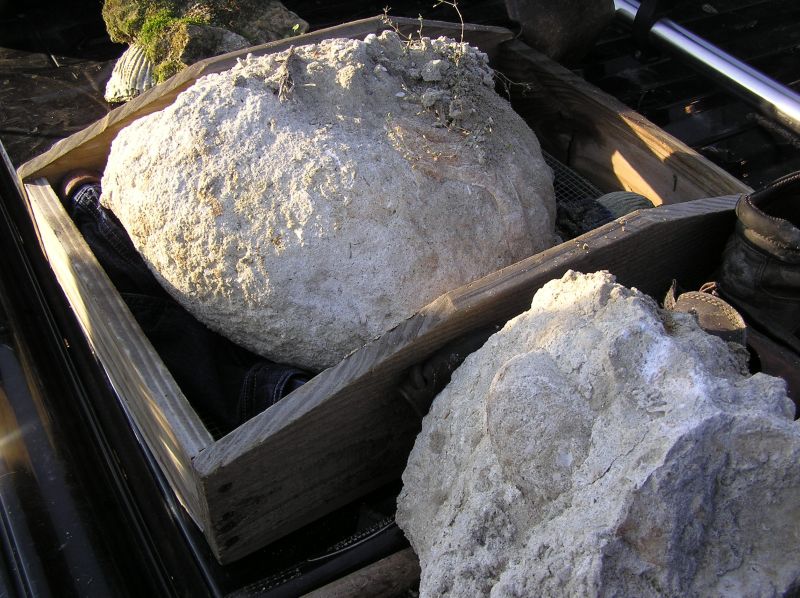
More nautiloid casts.
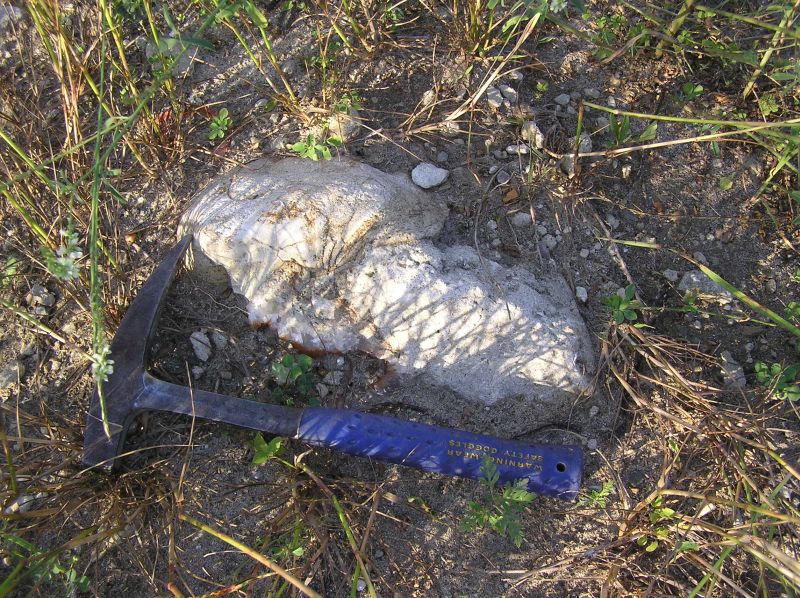
Claire found this piece of nautiloid barely out of the ground. She dug quite a while to work it loose.
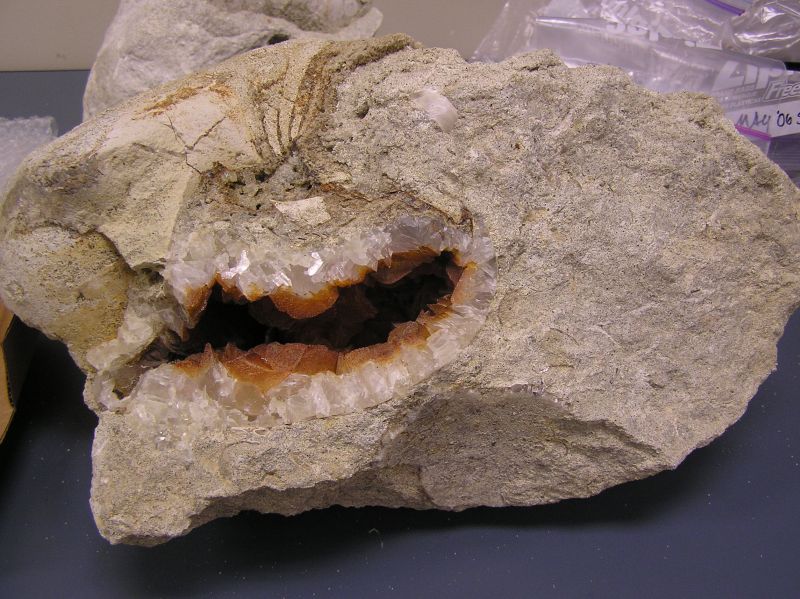
This is what Claire found inside the nautiloid after removing the matrix. Beautiful quartz crystals!
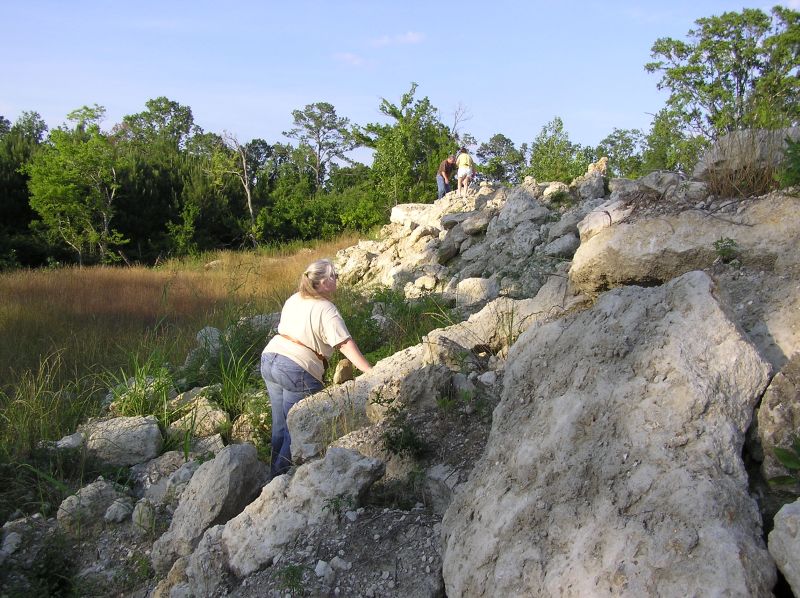
Martha searching for an easy way up, which required the skills of a mountain goat!
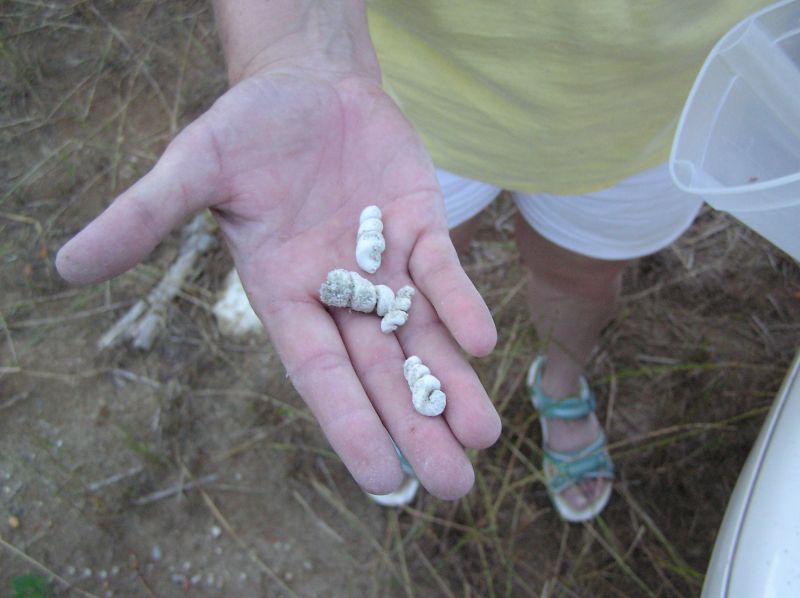
Becky has found some nice gastropods.
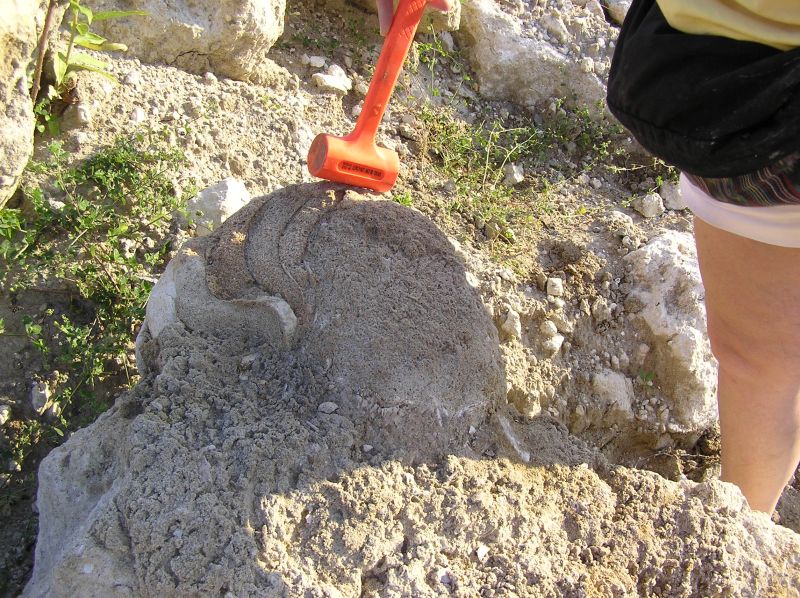
And a large nautiloid cast in extremely hard rock!
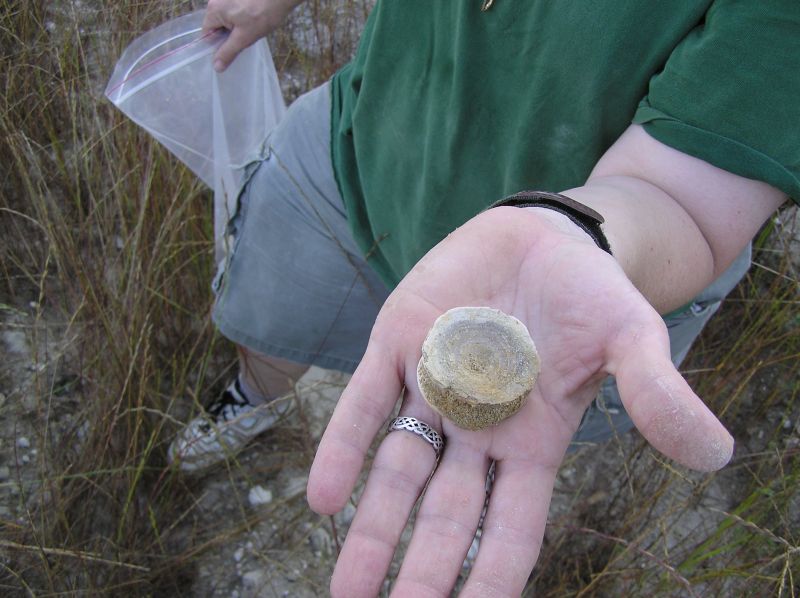
Claire had a very nice day. In a wash near the nautiloid filled with crystals, she found this large vertebra.
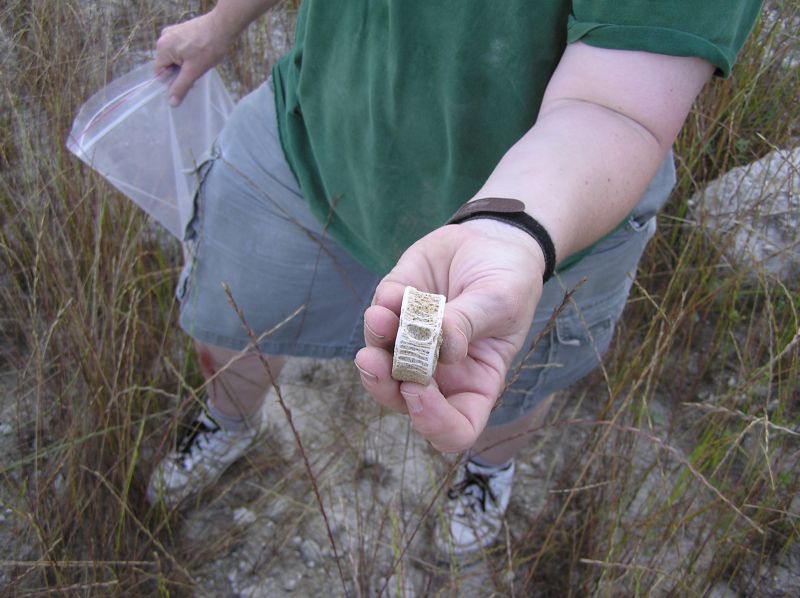
Side view of the vertebra.
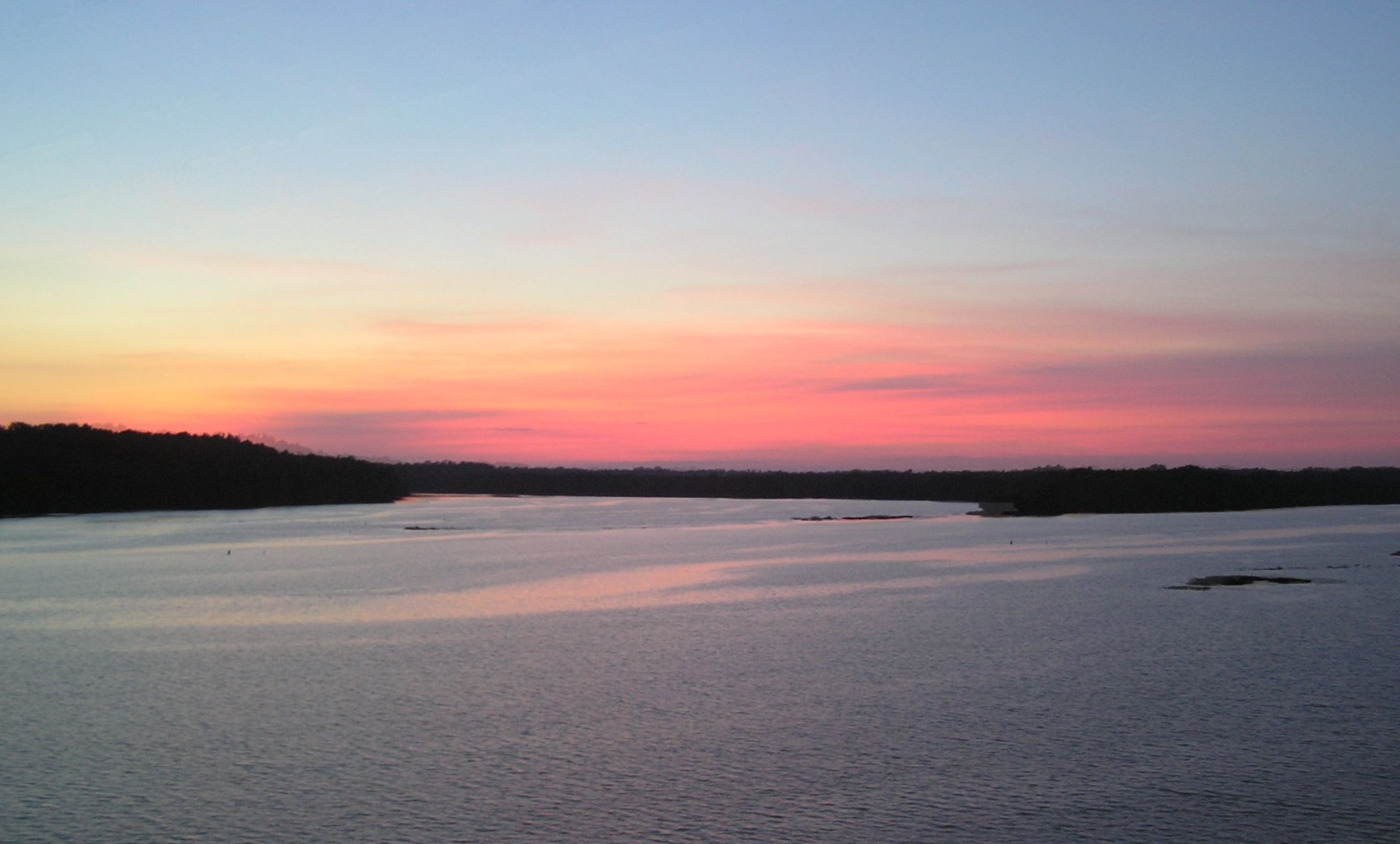
As the die-hard fossil hounds called it a day, we were treated to a beautiful sunset!
